Research on Wind Environment and Morphological Effects of High-Rise Buildings in Macau: An Example from the New Reclamation Area around Areia Preta
Abstract
1. Introduction
1.1. Research Background
1.2. Literature Review
1.3. Problem Statement and Objectives
2. Study Area and Methods
- Determine how urban form influences the wind environment and investigate the characteristics and causes.
- Examining the potential typhoon damage to high-rise buildings and its causes by comparing the calculated standard value of wind load with the simulation results.
- Determine the relationship between wind environment parameters and urban design parameters, and propose control strategies to improve the urban wind environment.
2.1. Study Area
2.2. Simulation Condition Setting
2.2.1. Computational Regions and Mesh Delineation
- (1)
- Calculation area configuration: moderately adjust the grid density distribution according to the distance from the building complex itself and determine the sizes of the X, Y, and Z axes, which are 490, 1960, and 300, respectively.
- (2)
- Grid magnification factor: specify the grid spacing; the minimum is 5 m in the central area and 20 m at the edge, and the magnification factor near the center is 1.5 (Figure 3).
2.2.2. Field Survey Data Correction
2.2.3. Computational Boundary Condition Settings
- (1)
- In the calculation model, the K-turbulence model is employed, and ‘GASES’ gas No. 0 is selected as the gas type.
- (2)
- Choose a calculation condition model. The KEMODE turbulence model is frequently employed in simulations of outdoor wind environments.
- (3)
- In the urban gradient wind, the wind is affected by the roughness of the ground below a height of 300 m. In the process of software simulation, the empirical formula can be used as the expression of the wind speed profile to calculate the wind speed at different heights:where US denotes the reference height, Zs denotes the average wind speed, and U(Z) denotes the average wind speed at height Z. Then, set the parameters according to the Chinese mainland green building design standard: “code for green design of civil buildings” (The Chinese Academy of Building Sciences is responsible for the interpretation of specific technical content. Green design applicable to new construction, renovation, and expansion of civil buildings is the most authoritative sustainable design criterion in China). It uses the basic scale, technical requirements, and technical measures as the principles of sustainable design. The incoming wind direction in this paper is 0.3 in summer and 0.12 in winter, based on the actual situation of the new reclamation area in Areia Preta, and the gradient wind height is 550 m.
- (4)
- Input the wind parameters of the building’s environment into the simulated wind environment, including wind speed, wind direction, and wind surface roughness.
3. Daily Wind Environment Characteristics and Building Complex Morphological Analysis
3.1. Wind Environment Simulation at Two Altitudes: Pedestrian Height and Standard Height
3.2. Influence Analysis of Morphological Elements of a Building Complex in Areia Preta
3.2.1. Analysis on the Control of Street Height-to-Width Ratio on Ventilation Channels in Areia Preta
- (1)
- In Table 1, the wind speed ratio (that is, the range of wind speed change) is further from 1.00, indicating a greater probability of wind speed change at both measuring stations. Numerous turbulent winds and vortices are present, and the local wind speed is greater than that of the surrounding area, or the wind field is chaotic. The closer the ratio is to 1, the smaller the possibility of wind speed variations on both sides of the place, which may be in a calm wind or laminar wind region. At the same time, the link between the height-to-width ratio of streets No. 1, 2, and 3 and the wind speed ratio between the wind intake and wind outflow is decreasing. According to this region’s wind environment features, the ratio of street height-to-width is inversely related to the wind speed ratio. In the future, it will be required to regulate the height-to-width ratio of streets in similar urban planning projects in order to avoid huge wind speed disparities or quiet wind regions.
- (2)
- The aspect ratio increase inhibits the bottom airflow. There is no correlation reference value for aspect ratio because streets No. 4, 5, and 6 do not share the same location variable. The aspect ratio of the adjacent street (No. 5) on the leeward side of the Residencia Macau is 4.88:1, which is an extraordinarily high ratio. The wind vortex generated on the top enhances the static wind state near the base, limiting the natural ventilation of the middle and lower floors of the Residencia Macau and La Cite and resulting in poor air quality. Over street No. 4 at this moment, the aspect ratio is 3.31:1, the wind speed near the ground is increased, and the vertically created wind vortex is stronger than the near-surface vortex. When the winter monsoon hits the 4th, 5th, and 6th streets, the air outlets are situated at the intersections of the streets, facing more complex multidirectional incoming flows. This causes a greater wind speed ratio, which represents the complexity of the wind field at the intersection.
3.2.2. Effect of Street Orientation on Areia Preta Ventilation Corridors
- (1)
- When the orientation is 0°, the simulation reveals that the north–south street is the prevailing wind ventilation channel under the north–south wind, and the internal airflow is relatively active, flowing down the canyon space of the street. On the street in the inner center, however, there is a phenomenon of two airflows converging, hedging, and encountering a downhill rushing wind when going upwards, which impairs pedestrian comfort. Overall, the airflow inside is quicker than the wind speed at 45°, there is a big area with a breeze above 2.5 m per second, and the ventilation state is good. However, the streets between La Marina—the Residencia Macau and the Residencia Macau—Villa de Mer have pronounced wind funnel effects, and the wind speed fluctuates substantially, which has a pronounced short-term amplifying effect on the passing airflow. In addition, there is a significant area of severe wind greater than 5 m/s at the building’s exterior corner. In comparison to the 90° orientation, the strong wind area at the bottom corner of the podium is more apparent in the 45° orientation. When buildings are oriented at 90°, the same phenomena occur, but the wind funnel effect and corner effect are more pronounced. When facing at a 90°, there is more turbulence in the inner block, and wind from numerous directions converges and intertwines elaborately in the inner street. Positive 90° and positive 0° are factors associated with more unfavorable wind field environments because they result in a more chaotic wind field environment, which has a relatively bad effect on ventilation, pedestrian comfort, and bottom safety.
- (2)
- In the present 48.2° and 45° orientation simulations, after the entering wind makes contact with the building complex, its performance is relatively balanced in all respects, and there is no wind speed greater than 5 m/s overall. When the wind blows from the north at an orientation of 48.2°, the wind speed on the majority of streets is between 0 to 2.4 m/s, which is not conducive to the normal ventilation and heat dissipation within the building complex. In addition, it increases the area of the building’s wind shadow area, so it can be concluded that the present orientation of 40.3° is one of the causes of the building group effect. This simulation demonstrates that when the alignment of the roadway is completely parallel to the direction of the incoming wind, a uniform laminar airflow with an increasing wind speed with height is produced. However, this will enhance the likelihood of sudden gusts of wind, and the street corner will have a greater concentration of strong winds. At this moment, improvements can be made by enhancing the form and aspect ratio of the street plan. When the windward angle of the building is close to 45° to the prevailing wind direction, the problem of internal ventilation and structures blocking the downwind direction may be well solved, and the effective span of the windward side of the building group is considerably different. The prevailing wind throughout the year decreases to create a uniformly distributed outside wind field. Therefore, the high-rise residential neighborhood in Areia Preta has a good ventilation penetration effect in the face of the yearly predominant north wind, and the downwind direction and local streets can be better ventilated. As a result of the pattern spacing of high-rise structures, there are still small wind dead zones in streets perpendicular to the direction of incoming wind. In conjunction with the control indicators of the street height-to-width ratio and line-pasting rate, a thorough investigation and evaluation are undertaken, and the urban form control strategy for future urban design in similar situations may be established.
3.2.3. Building Complex Frontal Region
3.2.4. Arrangement of Building Heights
3.2.5. The Influence of Group Combination on the Formation of Monomers
- Due to the large aspect ratio of the building itself, the degree of enclosure, the large aspect ratio of the building groups, and the windward area ratio, as well as other morphological factors, the surface wind speed near the inner streets and podium buildings in winter and summer is greater than that of the outer streets. These are commonly low. A large area of wind shadow and vortex areas appeared in the sky, which weakened the ventilation efficiency and led to a poor ventilation environment within the high-rise buildings of Areia Preta.
- The region of highest positive pressure appears on the leeward side of Winter Sea Residence and Grand Hyatt Bay. The narrow spacing between the former building layout and the 15° orientation of the tower exacerbates the narrow tube effect, thereby doubling or tripling the wind velocity. Because it is U−shaped, the latter is good at spreading out the incoming wind in the winter, which increases the airflow in the back and lowers the pressure difference caused by the negative pressure in the back.
- At the opening of the exterior block and the building’s corner, the wind velocity is greatest. Due to the angle of deflection between the street orientation and wind direction, there is a corner effect at the intersection and street opening, which increases the local wind speed.
- Because of building shading, the L−shaped plate building’s overhead floor does not help much with ventilation and heat loss, and the vortex wind has a lot of trouble with the podium roof.
4. Analysis of Potential Damage Caused by Typhoon Weather
4.1. Analysis of Typhoon Simulation Environment Results
4.2. Analysis of Vulnerable Parts of Building Monolith and Standard Floor Plane
4.3. Analysis of Building Groups and Vulnerable Parts of Facades
5. Conclusions
Author Contributions
Funding
Institutional Review Board Statement
Informed Consent Statement
Data Availability Statement
Acknowledgments
Conflicts of Interest
Appendix A. Experimental Simulation Process and Results: Wind Environment Simulation at Two Altitudes: Pedestrian Height and Standard Height
| Working Condition | Season | Wind Direction | Wind Speed (m/s) |
|---|---|---|---|
| 1 | Summer | S | 3.36 |
| 2 | Winter | N | 3.93 |
| No. | Results | Simulation Process Analysis |
|---|---|---|
| 1 | A calm wind zone is formed above the Avenida da Ponte da Amizade and the internal streets. | Through the simulation, it is found that there is no area with a wind speed greater than 5 m/s in the whole area. The southward monsoon is prevalent in Macau in summer, and a certain range of stagnation areas are formed on the windward side of the southward building complex, where the wind speed is between and 1 and 2.5 m/s. A large wind shadow area appeared in the north, and the minimum wind speed dropped to 1 m/s or even as low as no wind. The wind shadow area directly covers the main road in the north (Avenida da Ponte da Amizade). The low wind speed makes it easy to form an accumulation of exhaust gas and reduce the air quality (Figure A1, the red circle frame). The canyon wind effect appears on Central da Areia Preta and Rua 1 de Maio in the plot, which together with the corner effect around the podium strengthens the ventilation effect of the block. The wind speed at the entrance of the street generally reaches 2–4 m/s (Figure A1, black circle frame). As the airflow advances inward, the wind speed gradually decreases from 2 m/s to 1 m/s, and a certain range of windless areas appear around the Macau Baptist College and Rua 1 de Maio inside the plot due to the gradually decreasing wind speed (Figure A1, white round frame). This is not conducive to the ventilation and heat dissipation of the street in summer and the emission of pollutants, which increases the heat island effect and reduces the comfort of pedestrians in the Macau Baptist College playground and Rua 1 de Maio. |
| 2 | The corner at the bottom of the podium and the podium of the point tower are well ventilated. | The study found that the maximum wind speed was 1.5 m on the east and west sides of the building complex. Locally higher wind speed areas appear at the corners of the ground floors of the podiums on the southeast and southwest sides (Figure A1, the red box), with a maximum wind speed of 5 m/s. A large wind speed difference in a certain area at the same location can easily bring a small amount of discomfort to pedestrians, but it also enhances the ventilation effect at street corners. Under the same point layout, the wind speeds of the podiums of La Marina and Villa de Mer are more comfortable. The wind speeds of the podiums of the former (Figure A1, red circle frame) are relatively average, and there is no vortex and no wind area. Most of them are about 2.5 m/s, which is more favorable for outdoor activities in the summer. Referring to Figure A2, it can be seen that the wind on the roof of the podium house on the sea is composed of the downwind of the building after the upper tower is exposed to the wind, the airflow in the hallway at the overhead of the group of houses, and the secondary airflow formed by the composition of the building group. Under the interaction, a good north–south air flow is guaranteed. The large-area wind speed is about 3.5 m/s, which is good for outdoor activities in the summer, but the wind speed on the leeward side of the tower, that is, the north side, is relatively low. |
| 3 | There is a relatively large area of weak wind or calm wind on the roof of the podium of the large-scale, wide-slab building. | Referring to the section of the north–south central axis in summer (Figure A3), since the overall height of EDF. Polytec Garden is lower than that of La Cite and La Baie du Noble, it plays a certain role in blocking and buffering the incoming wind from the south. The incoming wind touches the first row of buildings and gradually increases its height, by passing the wake behind the south side of the EDF. Polytec Garden Tower. The vortex area (Figure A3, red box) is formed on the podium of La Cite and La Baie du Noble, and there is a large area of weak wind or even wind, and the maximum wind speed is only 1.3 m/s. Since the overall height of EDF. Polytec Garden is lower than that of La Cite and La Baie du Noble, it plays a certain role in blocking and buffering the incoming wind from the south. The incoming wind touches the first row of buildings and gradually increases its height, bypassing the wake behind the south side of the EDF. Polytec Garden Tower. It can be seen that the overhead layer has a limited effect on the heat dissipation and ventilation of the podium roof in summer, and the quiet wind area will increase the utilization rate of air conditioners on the south side of the residence, which has a certain negative impact on the use of the podium roof in summer. |
| 4 | The internal street wind pressure is mainly a low pressure difference, and the external windward side is mainly a high pressure difference. | The summer wind pressure calculation results show that the maximum value is located at the south point of the windward side of the building group, which is about 5–8 Pa. Larger wind pressures appear at the corners of the podiums on the southwest and southeast sides of the building complex, and the value range is mostly 3–5 Pa, and the maximum is no more than 5 Pa. The pressure difference range on the windward side of the building is mostly 3–5 Pa, all greater than 1.5 Pa, which can ensure good ventilation indoors on the windward side of the first row outside the building complex. On the other hand, there are large areas of low pressure difference in the internal streets, mainly +1 to −1 Pa. It is speculated that most of the buildings housing shops in the inner streets may have poor ventilation and cooling effects. The minimum negative pressure value is consistent with the maximum wind speed found in the above research, and the pressure difference is about 10 Pa, which leads to an increase in local wind speed. |
| 5 | The building shape produces a wind vortex, a strong wind zone, and a calm wind zone. | In winter, the north monsoon prevails. Due to the large 0–2.0 m/s, and wide architectural forms of Villa de Mer and the Residencia Macau on the north side, there is a large area of wind area. There are also leeward sides of buildings on the south side of the plot, and the wind speed is generally in the range of 0–2.0 m/s. In addition, the wind speed at the north entrance of the Residencia Macau, which is the windward side, is also low, and there are vortexes and dead angles (Figure A4, red circle frame); the average wind speed in front of the entrance is less than 1 m/s (Figure A4, black round frame). The podium floors of Villa de Mer and EDF. Polytec Garden in the tower layout are more suitable for people’s activities, and the wind speed of both does not exceed 1.5 m/s (Figure A4, ed circle frame), which is good for outdoor activities in winter. On the other hand, the overall wind speed of the sea annex with the same tower layout is too high (Figure A4, black circle frame), and the wind speed in a large area is 7 m/s, which meets the standard for strong wind, which has a certain negative effect on the wind comfort of pedestrians. It is speculated that the airflow that produces a relatively high wind speed here is related to the plane form of the tower, the close building distance, and the high-intensity downwind of the upper floors. It can be seen that the due north airflow enters the place and turns when it encounters the building facade, resulting in the narrow pipe effect of the high wind speed phenomenon. |
| 6 | As the building height increases, the street canyon wind effect becomes more obvious. | At a height of 1.5 m, there is a more obvious street canyon wind effect on the southern side of Central da Areia Preta and Rua 1 de Maio inside the plot. The airflow moves along the depth direction of the street, and the overall wind speed ranges from 2.0 to 5.0 m/s (Figure A4, red box), which produces a good ventilation effect. For most streets, the wind speed is basically in the range of 0–2.4 m/s, which is an acceptable range for pedestrian wind comfort on winter streets but is also not conducive to the diffusion of pollutants when vehicles and buildings are running. When the height rises to 10 m, the overall wind speed of La Cite and La Baie du Noble is not much different from that in summer (Figure A5, red circle frame), and the wind speed in large areas is about 1 m/s. The air flow passes through La Marina and enters the interior of the Macau Baptist College and the upper part of Central da Areia Preta, and then the air flow advances along the horizontal direction of the street in depth, forming an obvious canyon effect. After passing through the wind gate, the wind speed gradually decays from 4 m/s to 1 m/s. |
| 7 | The podium at the corner of the plot is prone to local strong winds. | In the northwest and northeast corners of the plot (Figure A4, red circle), local gusts of >5 m/s appeared. The maximum speed can reach about 8 m/s, which has a great negative impact on the comfort of pedestrians. It is found that the air velocity ratio with the surrounding flow velocity is 2.5 times, and the airflow encounters the side of the building to form a circumvention and diversion phenomenon, resulting in a corner effect that affects the comfort of pedestrians to a certain extent. |
| 8 | The positive pressure on the flow surface is large, forming a high pressure difference between the front and back of the inner street and covering a wide area. | The northward monsoon is strengthened in winter because the north side is directly facing the sea. In terms of wind pressure in winter, it can be clearly seen that there is a large area of high pressure > 11 Pa on the windward side of the roof of La Marina and its podium on the north side. The pressure on the leeward side of the building in the direction of the incoming wind is only zero or even negative, and the pressure difference between the front and rear is much greater than 5 Pa. On the roof, due to the small distance between buildings, the vortices generated interfere with each other, and the local wind pressure increases significantly. The wind speed of convection is increased, which is not conducive to indoor heat preservation in winter. Another high pressure area is the Residencia Macau. Its unique arc-shaped plan layout forms a large area of positive pressure on the north side of the building when facing the incoming wind in winter, with values ranging from 12 to 14 Pa. In contrast to the normal state, when the air volume is constant, the greater the wind pressure, the greater the wind speed. The wind pressure here is high, but the wind speed is low. It is speculated that due to the arc-shaped plane layout, the downwind cannot escape from this area after bottoming out, resulting in dead ends. In winter, the north–south central axis profile, which shows that the layout of the screen building in the Residencia Macau has played a great role in hindering the residential area in the middle of the plot and that each downwind attenuates step by step (Figure A6). |

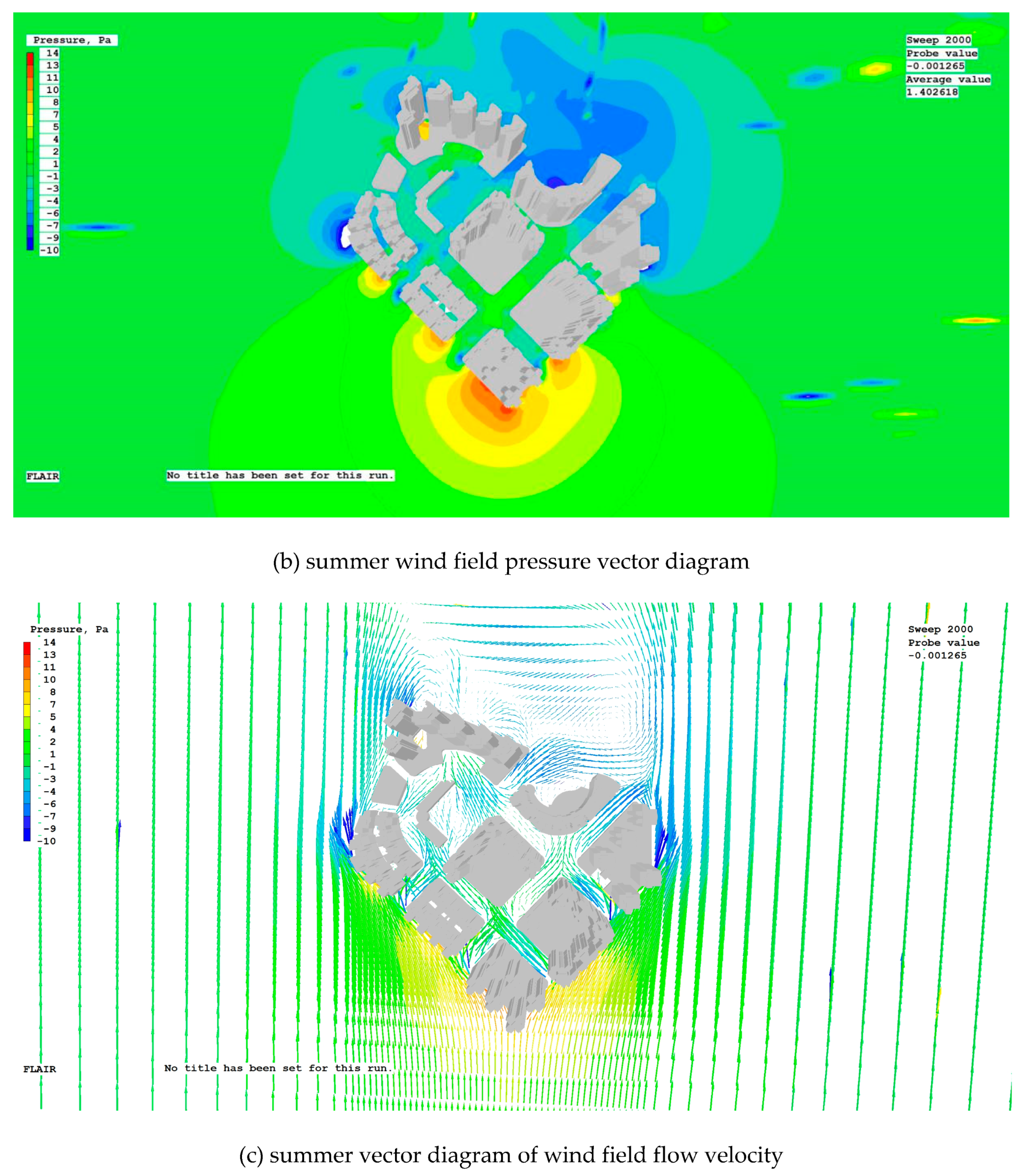
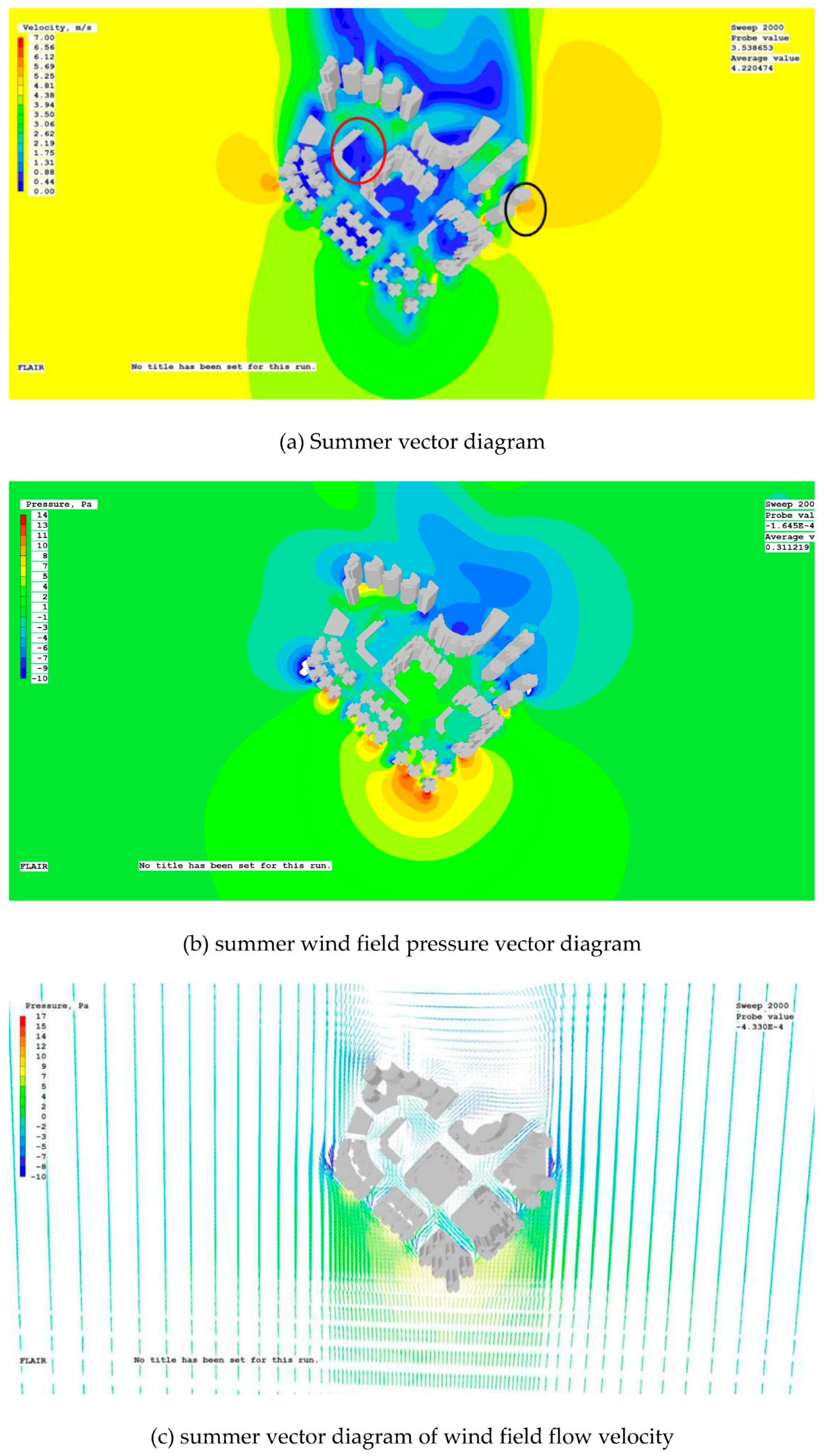
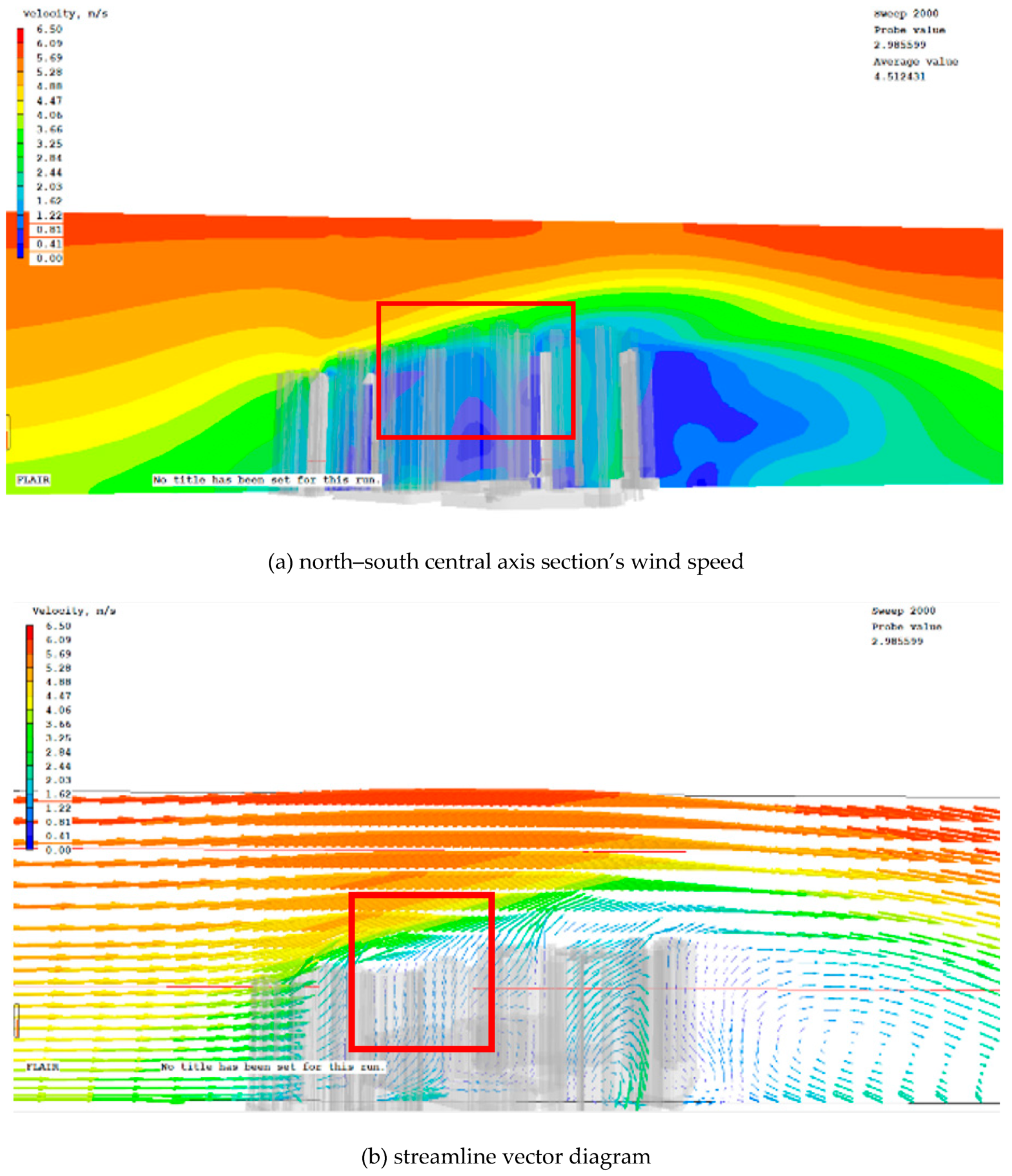
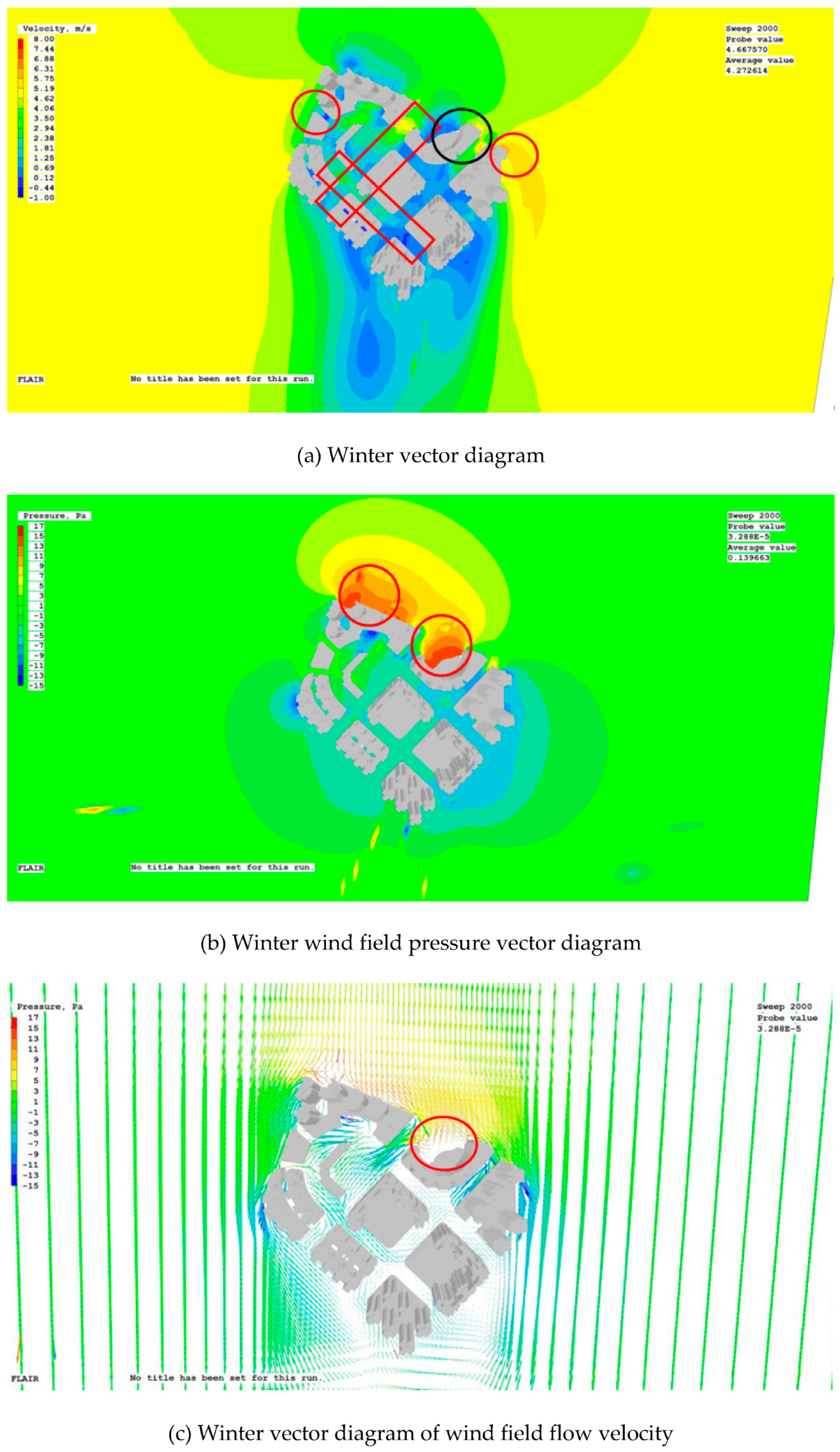
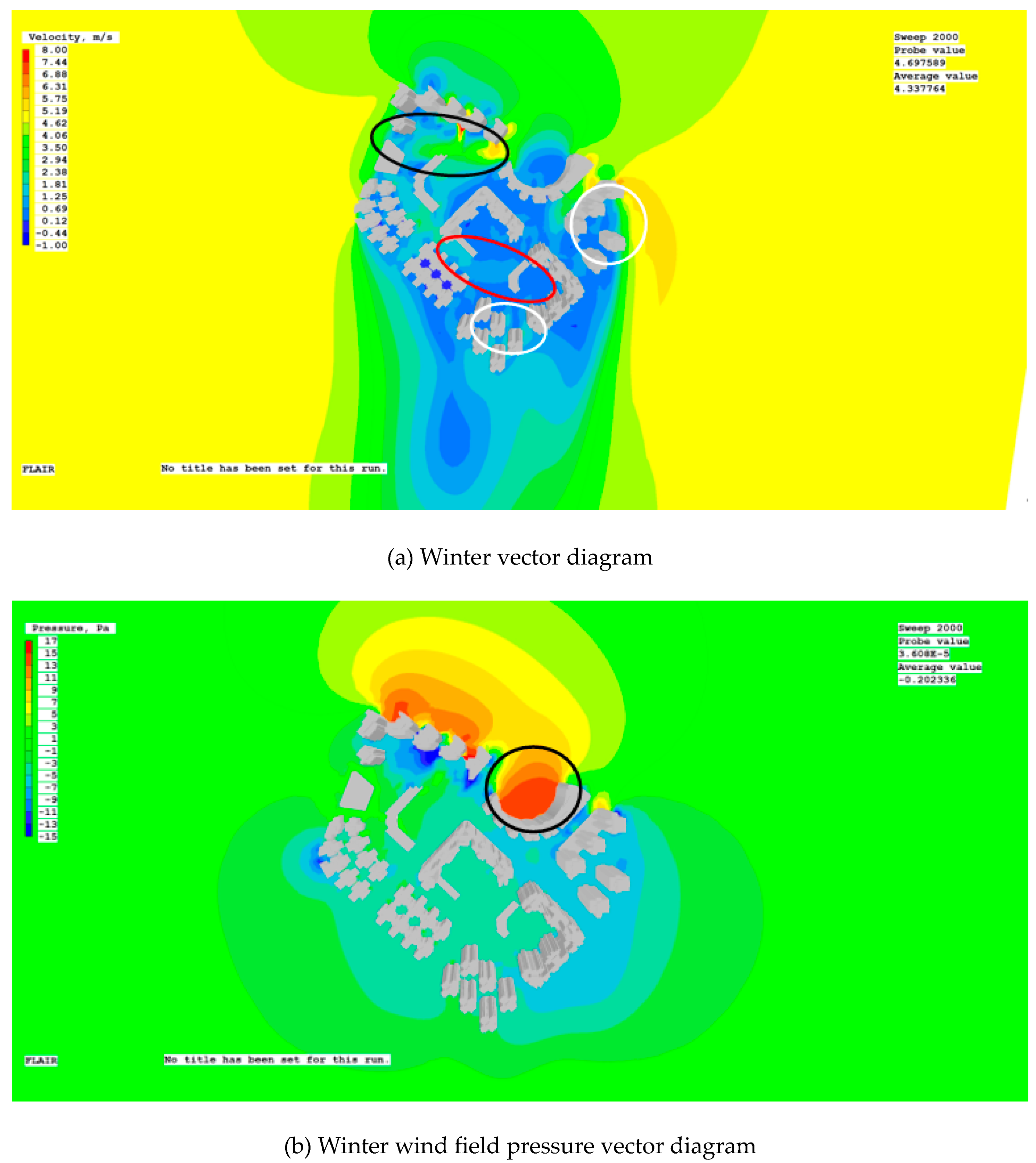
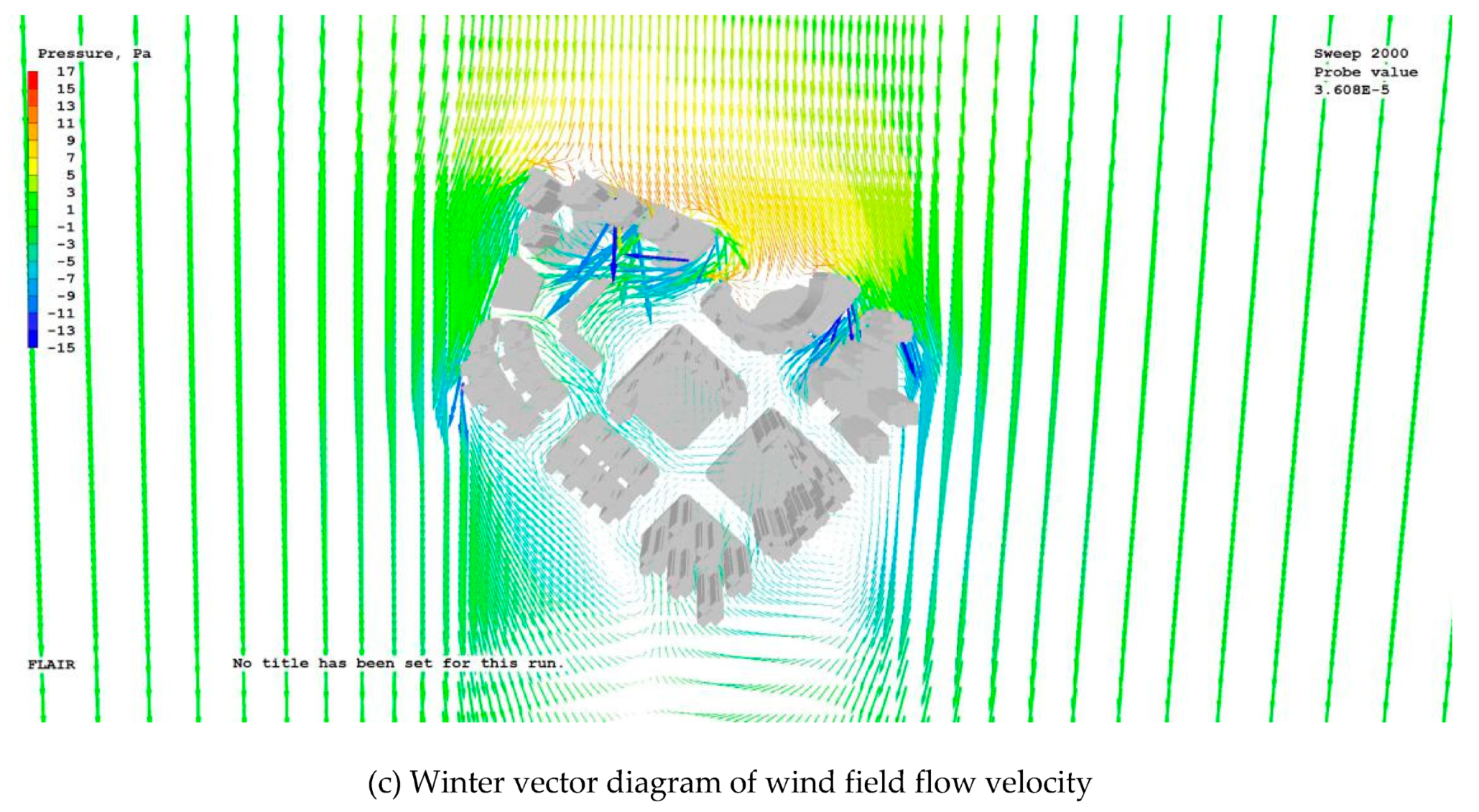
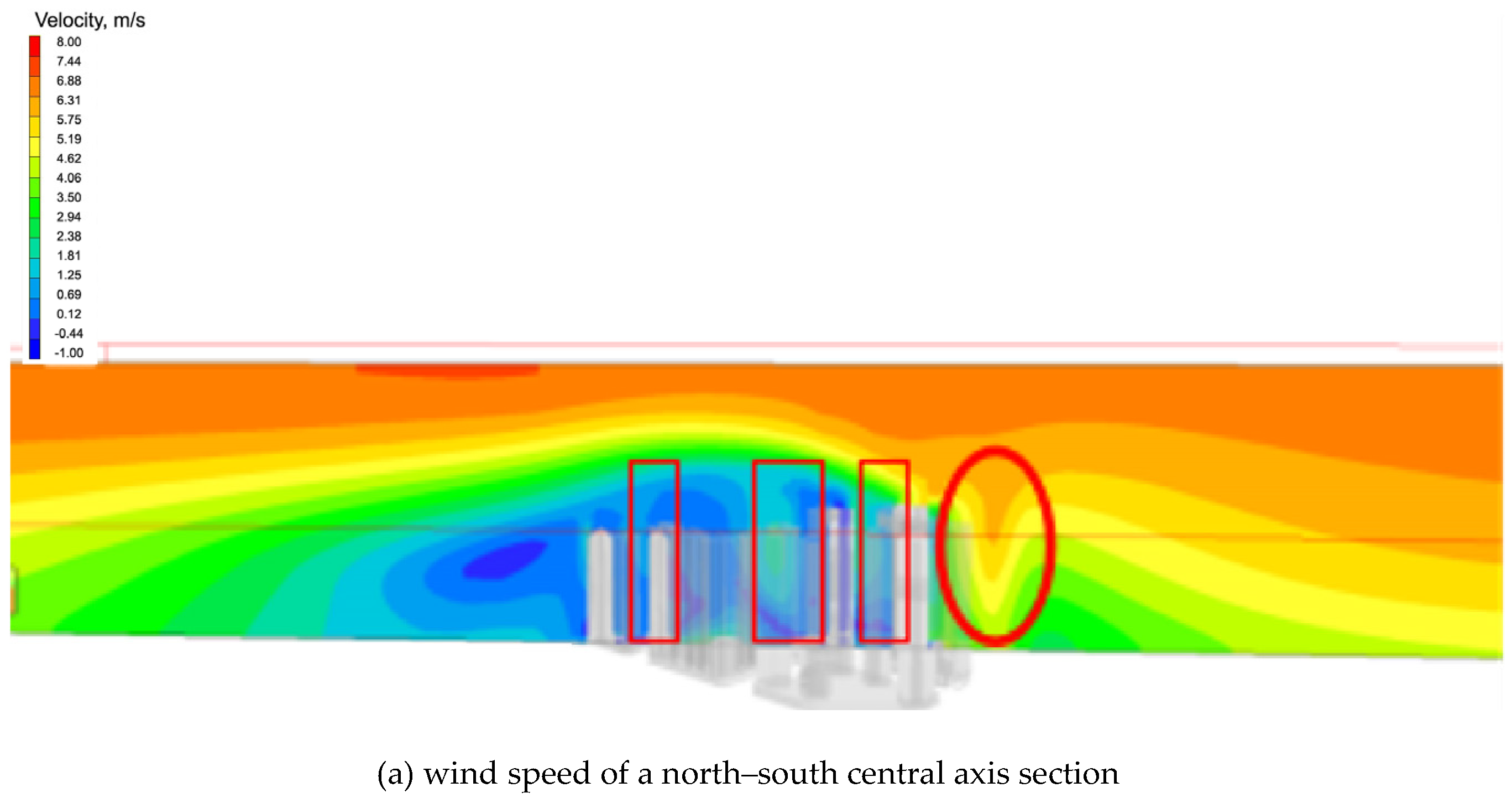
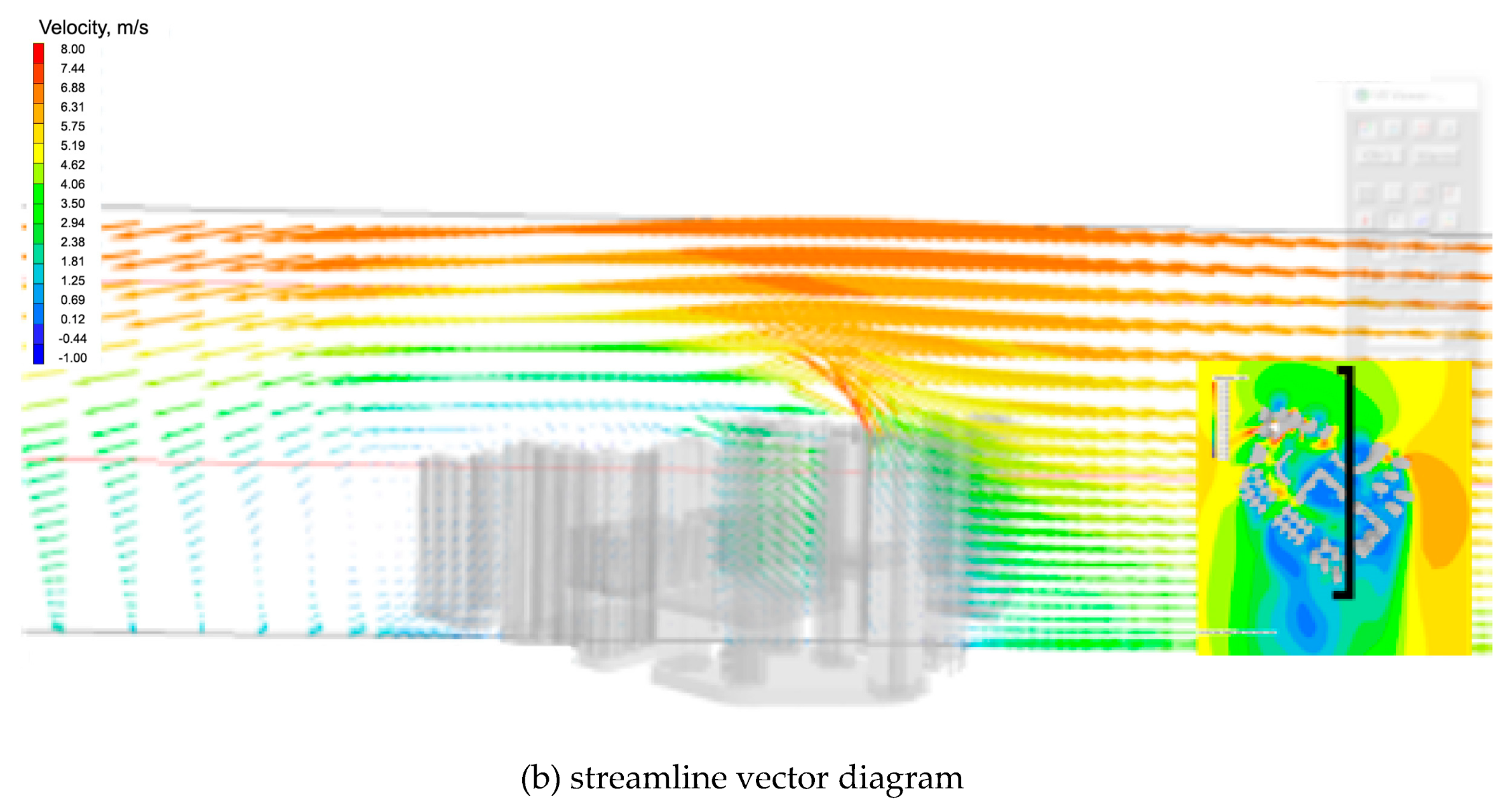
Appendix B. Experimental Simulation Process and Results: Influence Analysis of Single Building Form Design Elements in Areia Preta
| Building Name | Plane Form | Length-to-Width Ratio of Windward Side | Aspect Ratio of Windward Side |
|---|---|---|---|
| Villa de Mer | Point detached house | 0.86 | 4.56 |
| La Marina | Point detached house | 0.88 | 3.61 |
| EDF. Polytec Garden | Point detached house | 0.94 | 4.17 |
| the Residencia Macau | U-shaped panel splicing | 0.58 | 0.94 |
| La Baie du Noble | L-shaped panel splicing | 0.66 | 1.27 |
| La Cite | L-shaped panel splicing | 0.69 | 1.04 |
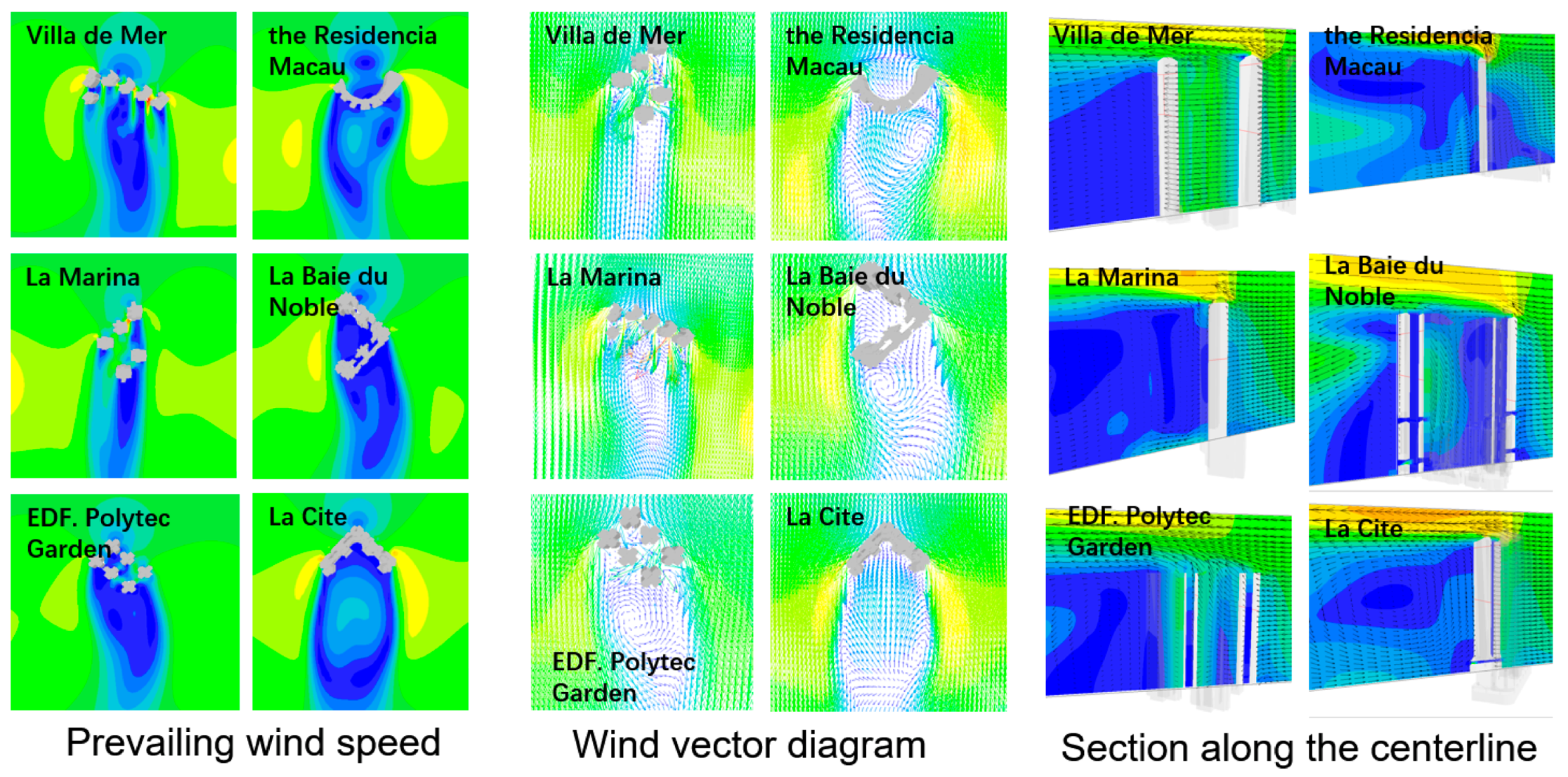
- (1)
- Challenges and methods for point cluster layout: According to studies, the building layout at La Marina is particularly tight, and the wind from the side walls converges, resulting in high wind speeds and amplifying the narrow tube effect. There is a comparable phenomenon in Villa de Mer, but the high wind speed phenomenon is concealed by the staggered arrangement, which increases ventilation distance, decreases the damper, and reduces the influence of the narrow pipe effect. A staggered point construction arrangement should be implemented in terms of the strategy for vertical interaction with seasonal incoming wind.
- (2)
- Problems and solutions for slab group design: The slab splicing layout in Areia Preta’s high-rise residential district connects many tall and large-scale structures to produce a continuous tall screen building in order to maximize the utilization of land value.

- (1)
- The orientation of the slab plane in Areia Preta should be 45–75° south by east. By simulating different incident angles, it can be determined that when the wind is blowing at an angle of 0° towards a slab building, the windward area of the building surface is greater and is inversely proportional to the incident angle. Therefore, in the Macau region, the slab pattern should be oriented between 45 and 75° south by east. The second is 90° straight south. When the entering wind is perpendicular to the building, the surrounding wind speed increases the most. The slab-type structure flows air between the leeward structure and the surrounding area, decreasing the structure’s barrier to urban ventilation.
- (2)
- The direction of the Areia Preta point plane should be 30° east by south, or 0°. Due to the square nature of the point plane, only four angles are chosen to prevent recurrence. The 45° incidence angle produces the largest wind shadow area, followed by the 15° incidence angle. At this time, the smallest area is between 0° and 30°, and the fraction of static wind area in the trial region is at its lowest. At 15° and 45°, the wind pressure is greatest, and the area of the windward surface is greatest at this concentration angle. In the Macau region, high-rise buildings with a point layout should use 0° from north to south or 30° from south to east as a design reference for orientation selection.
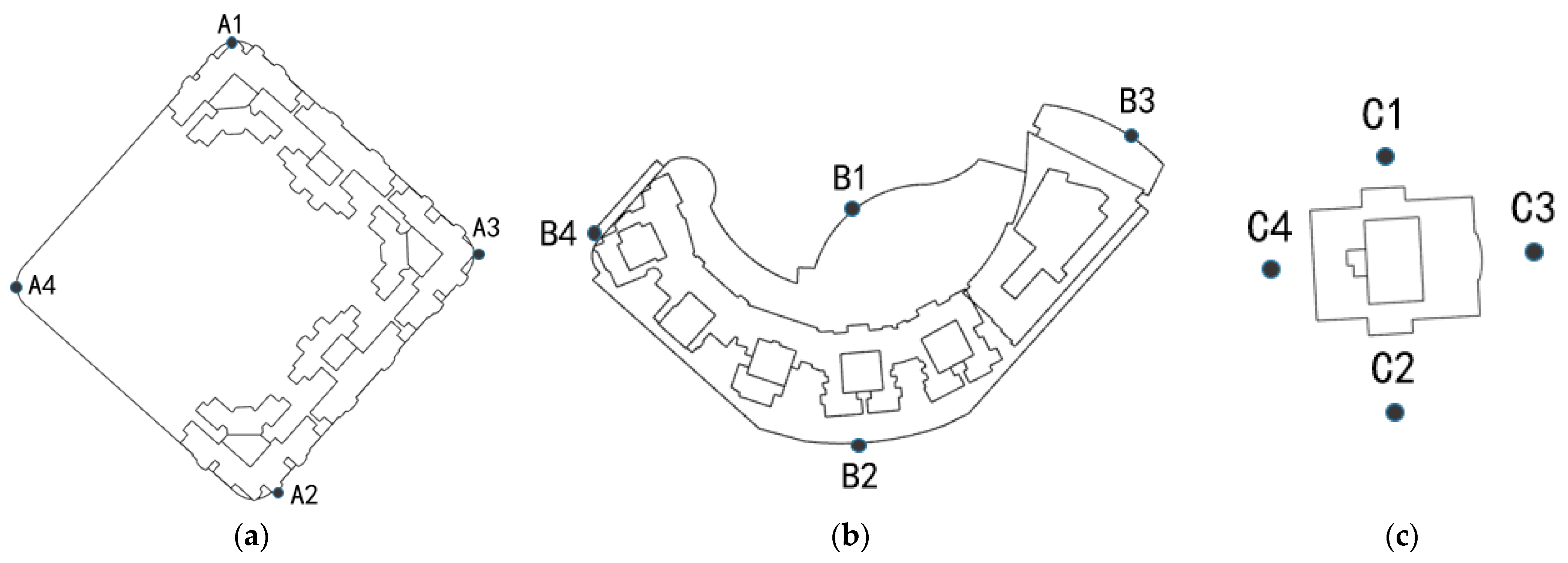
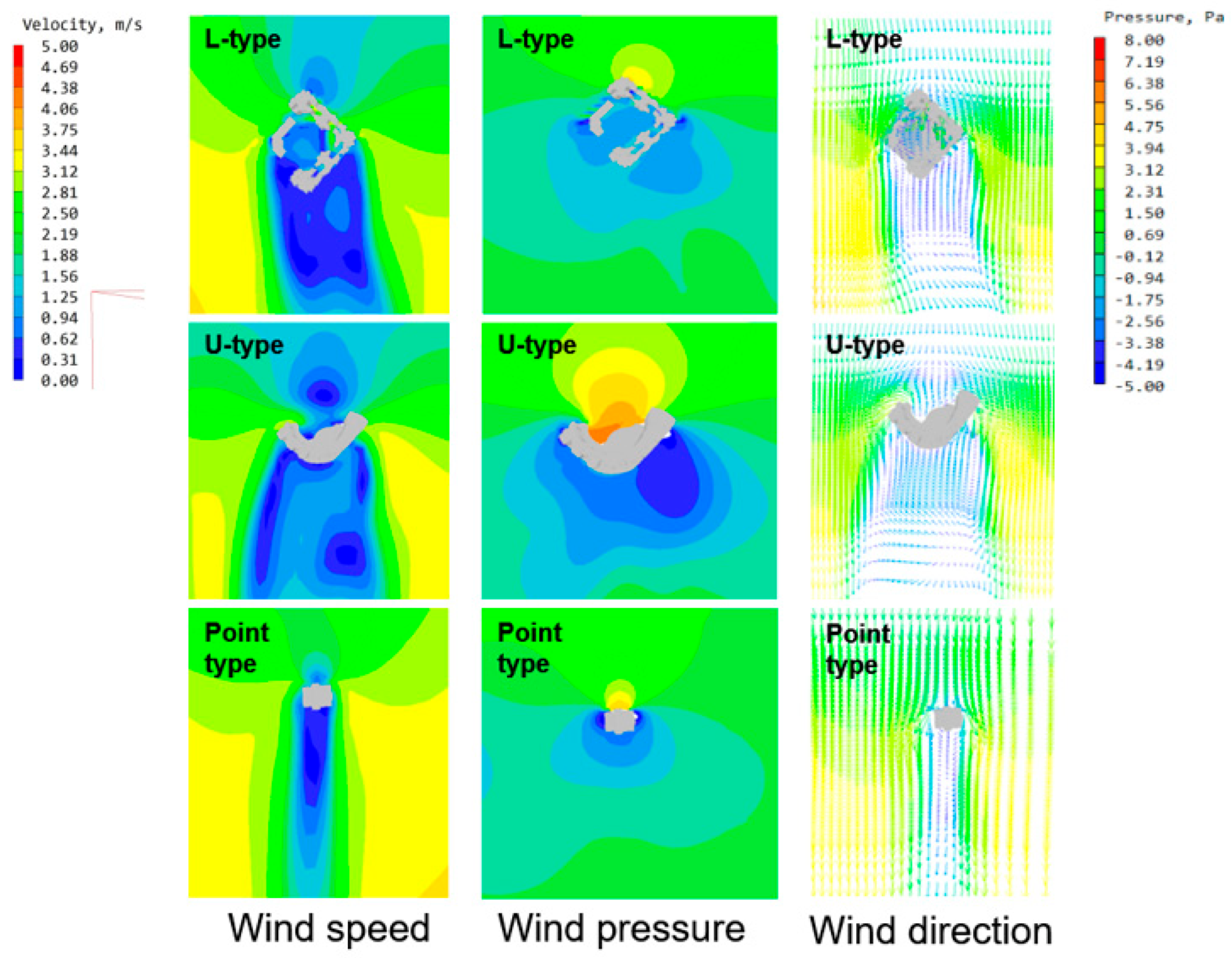
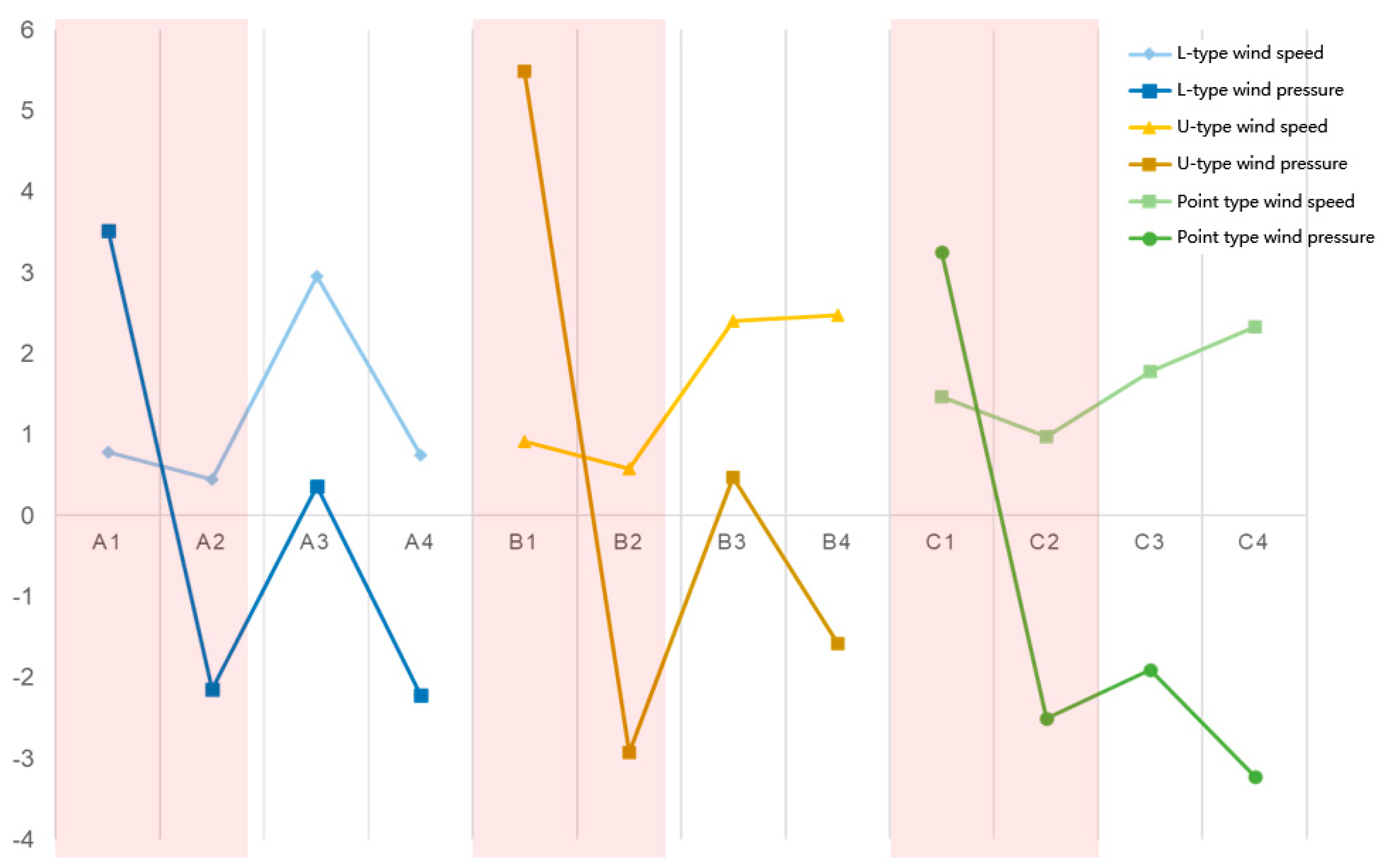
Appendix C. Experimental Simulation Process and Results: Typhoon Simulation Environment
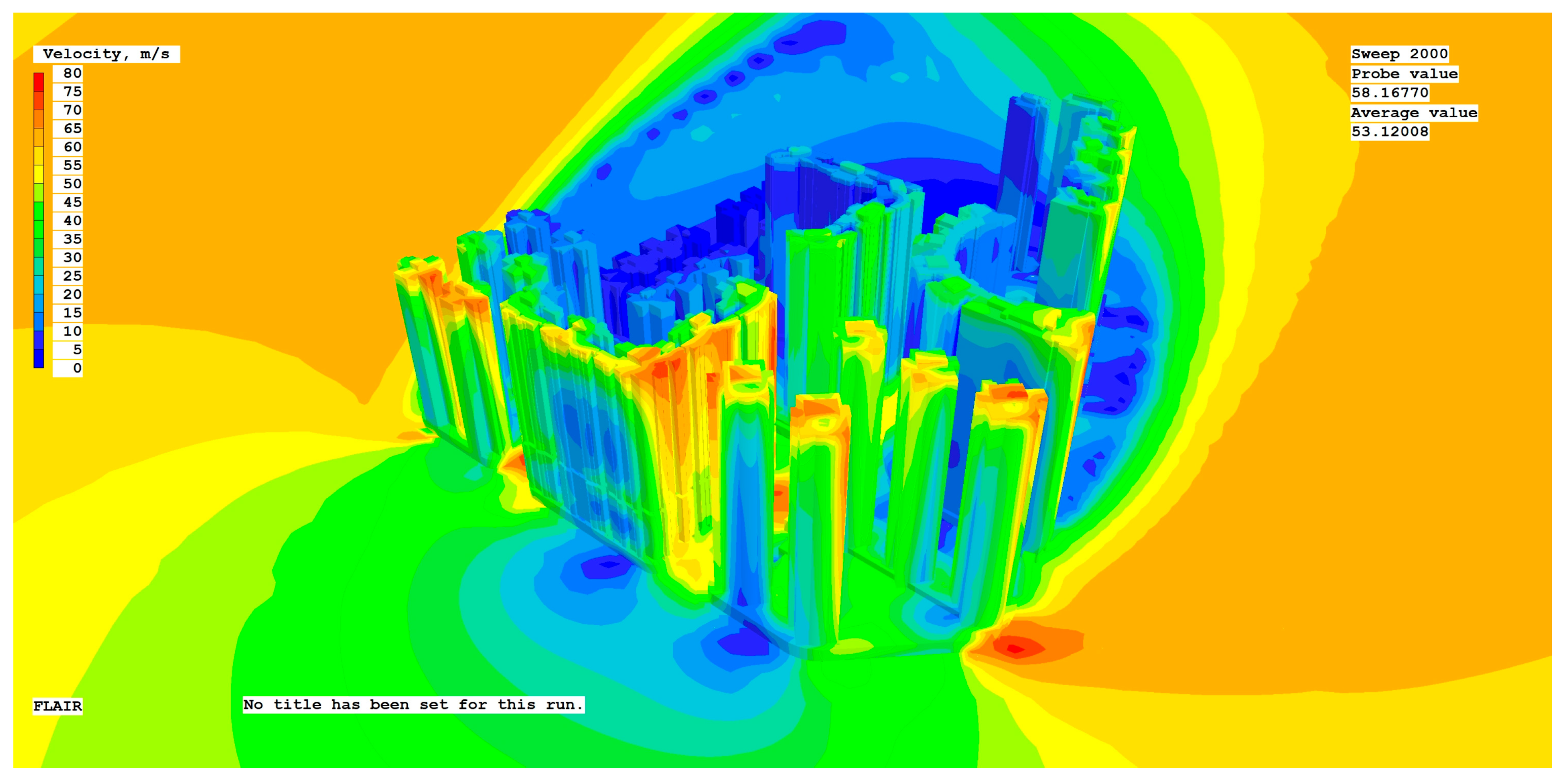

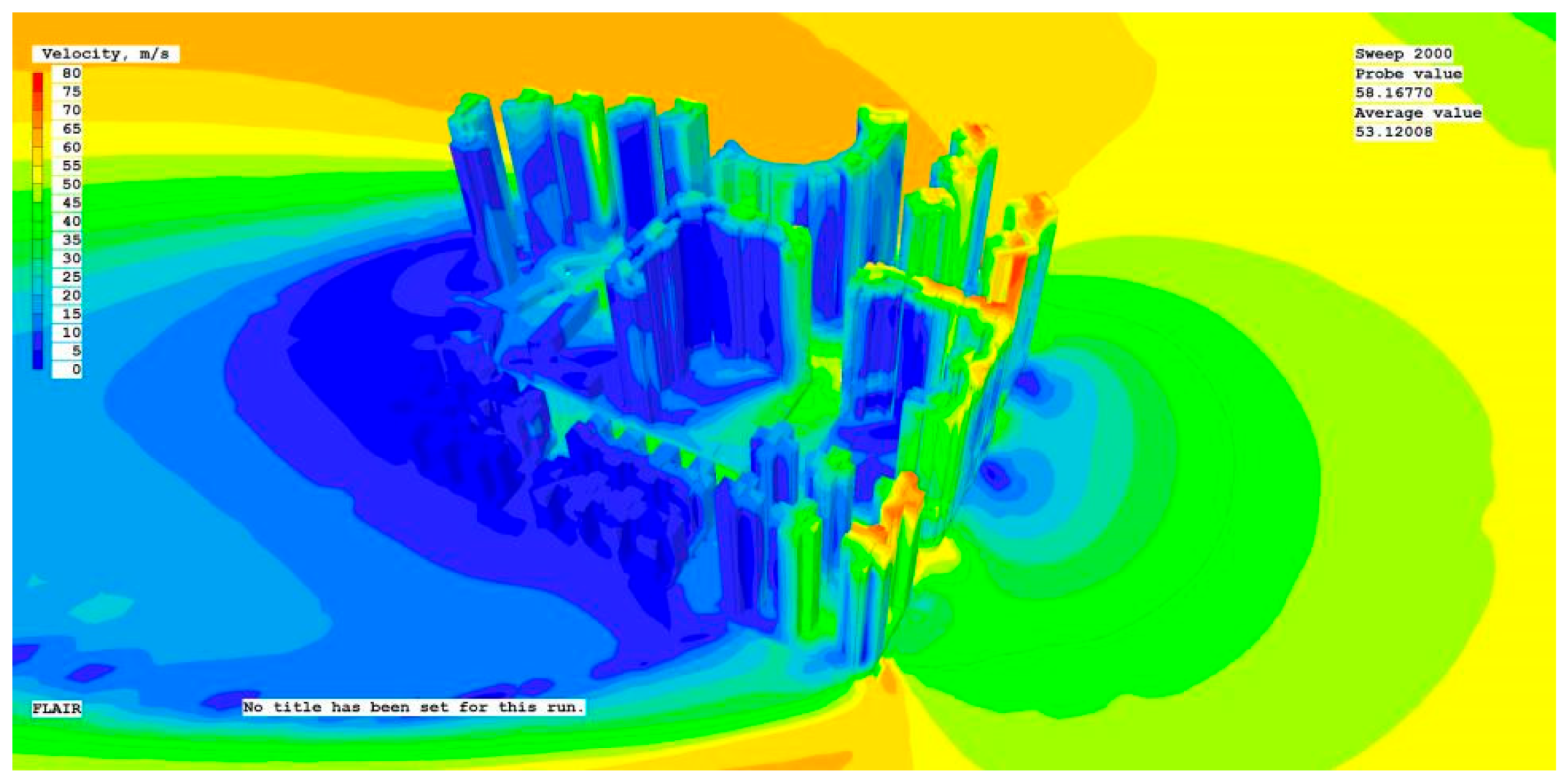
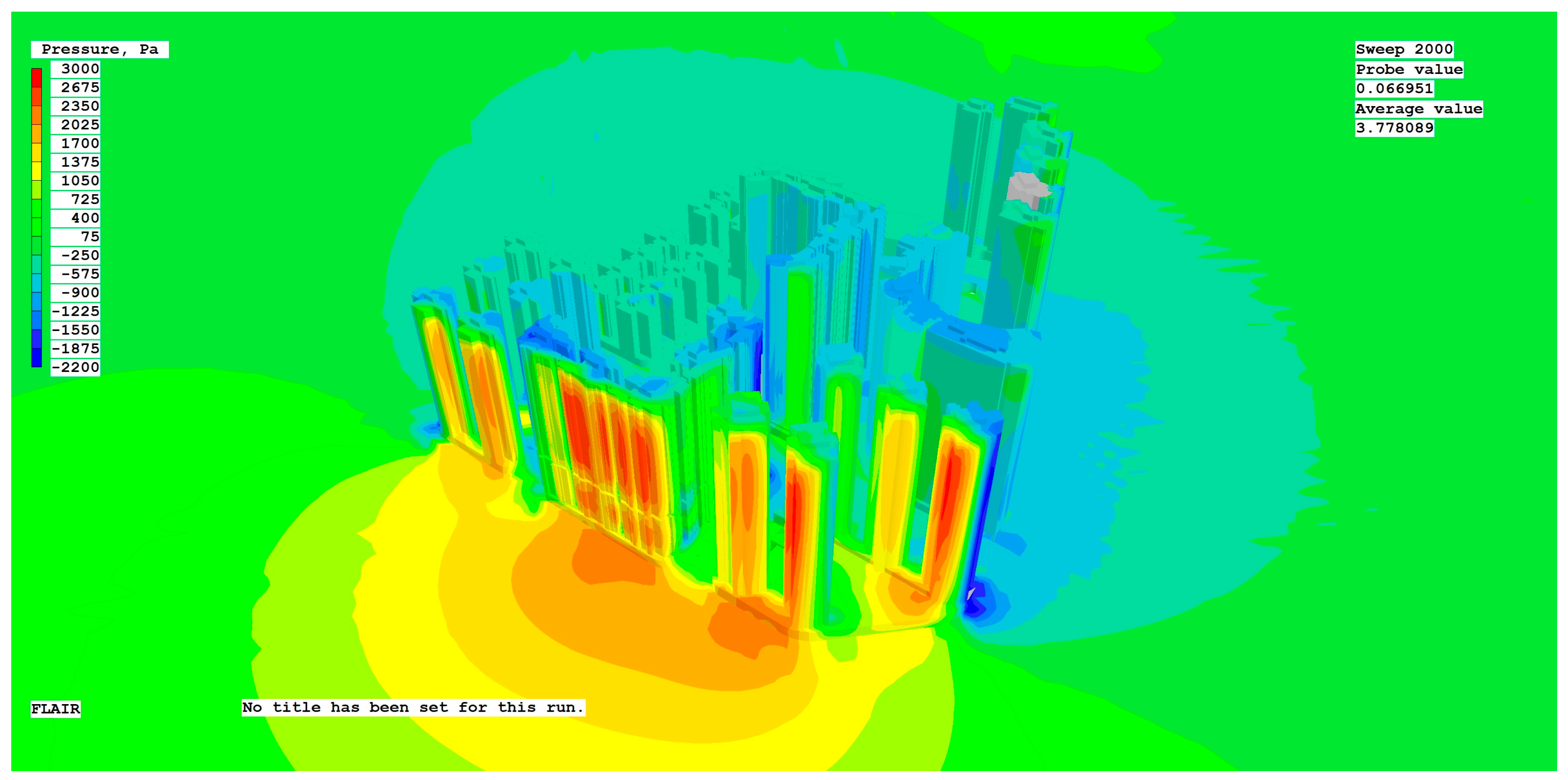
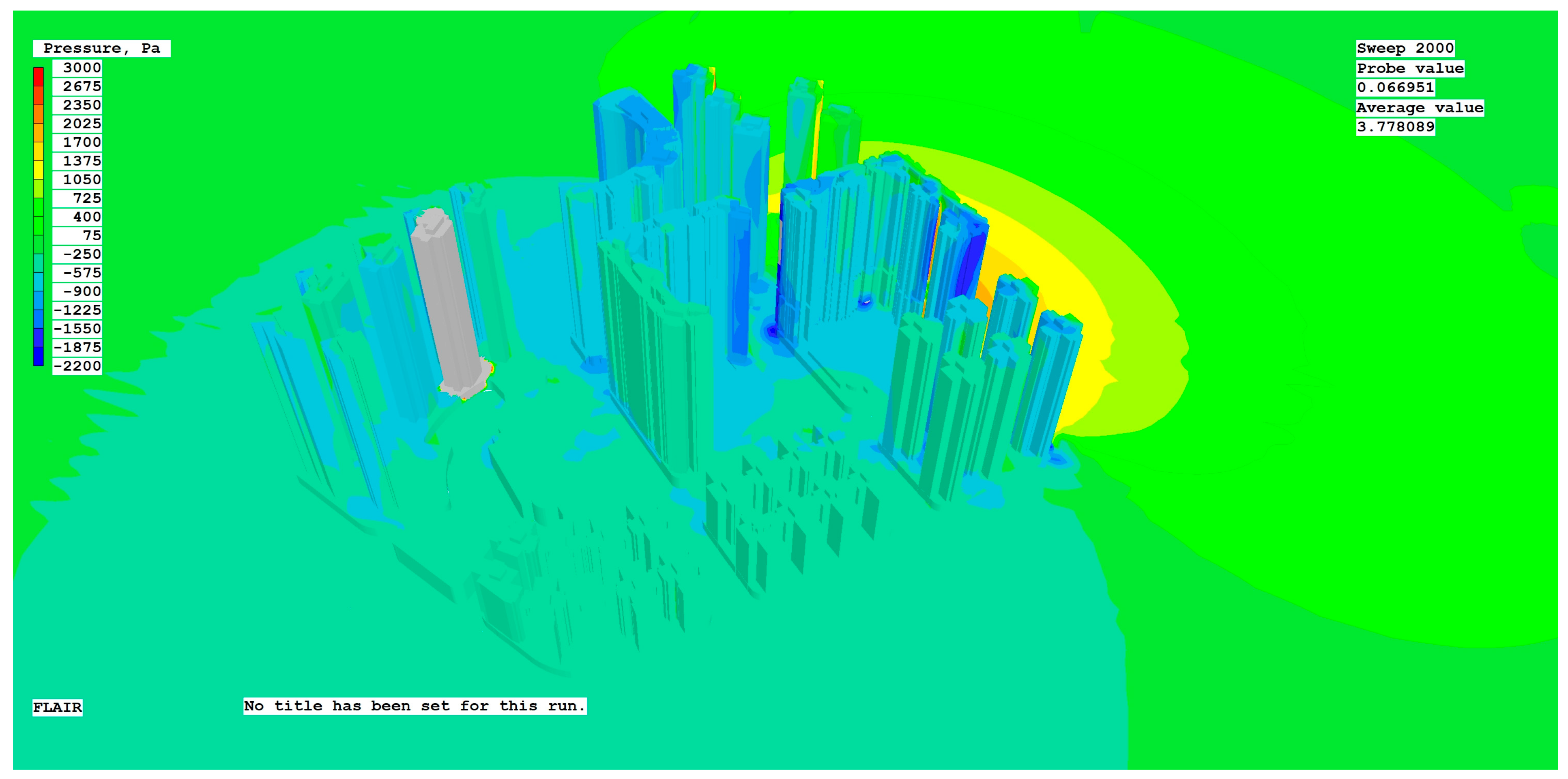
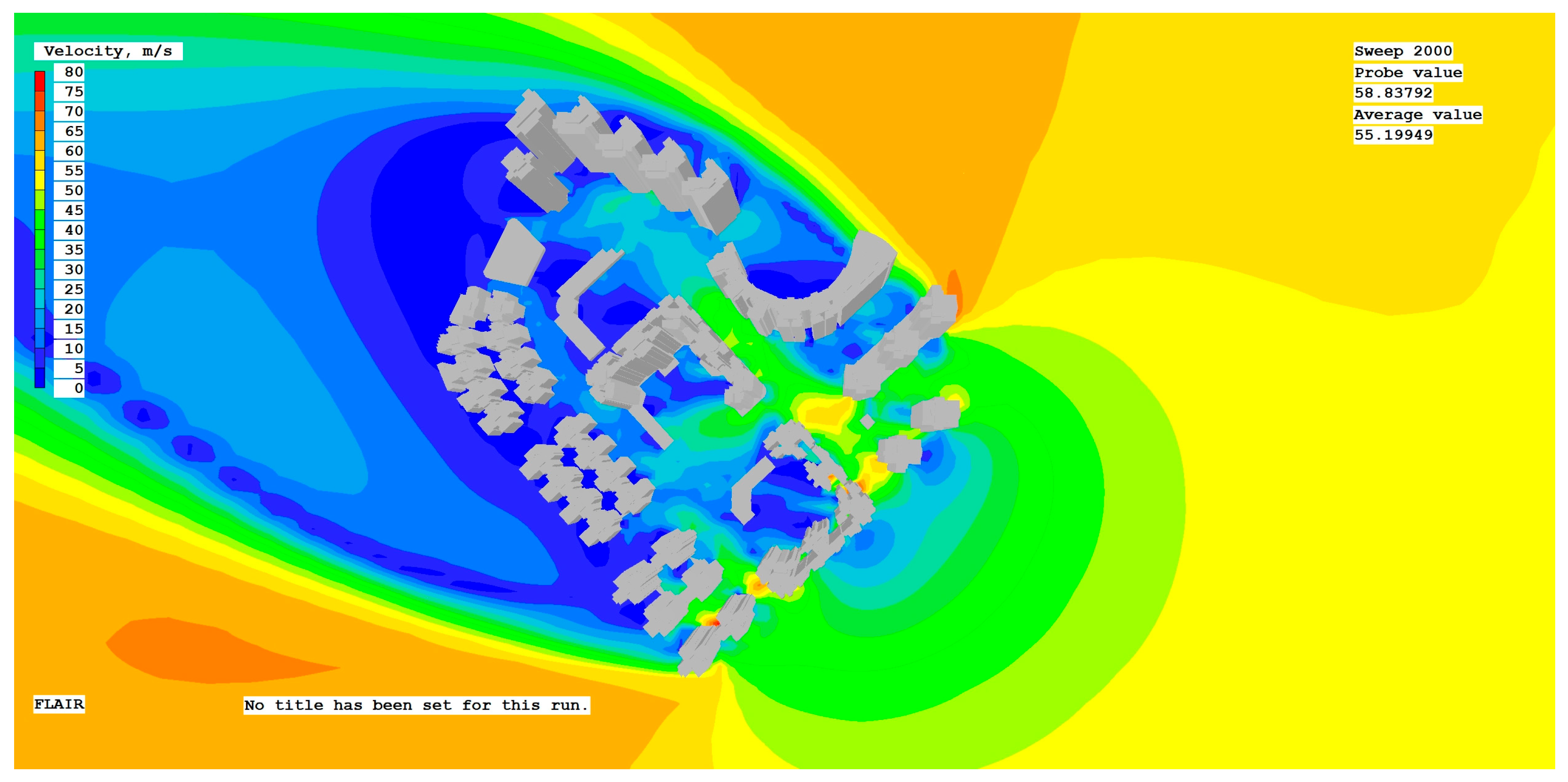
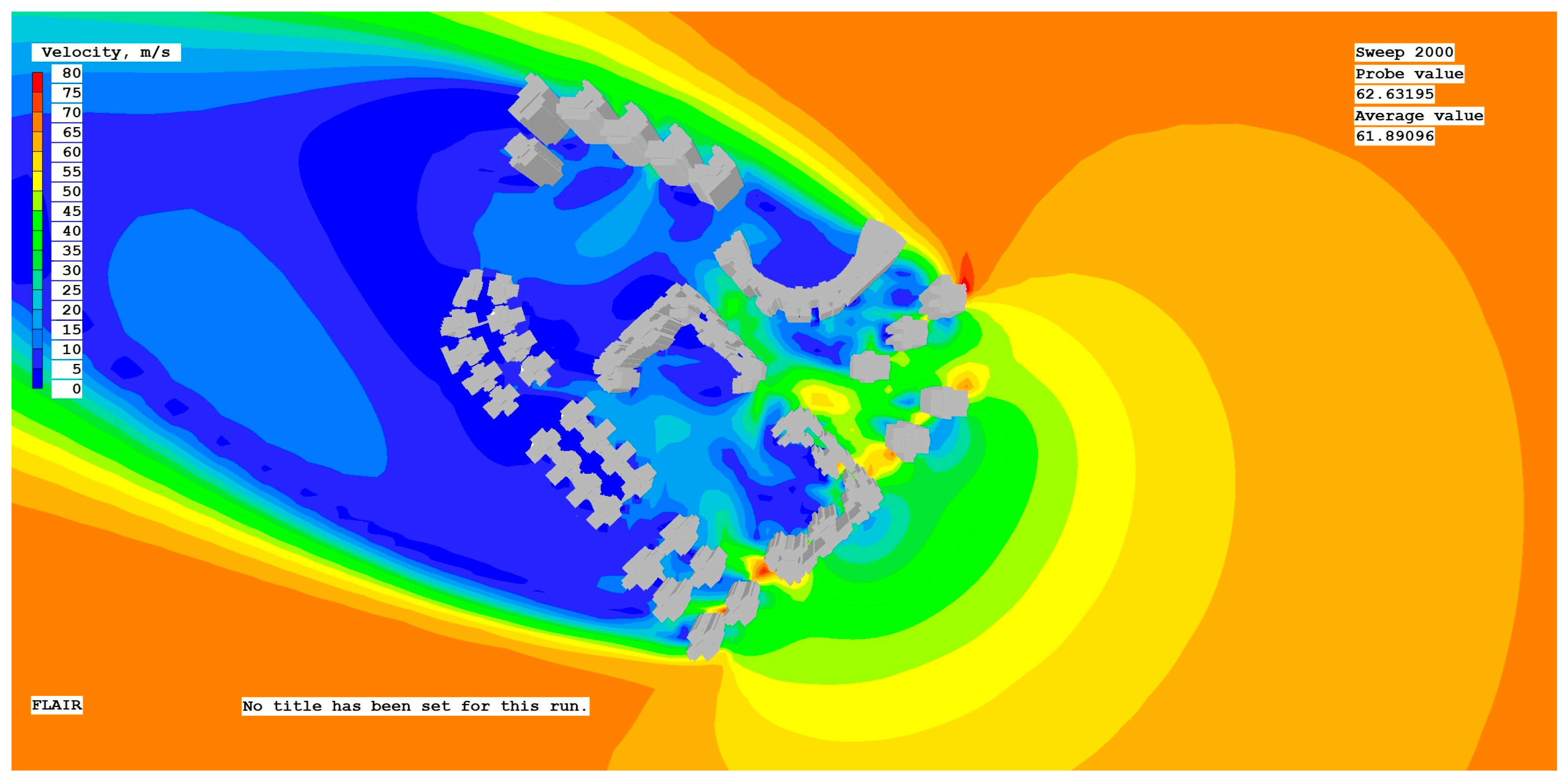
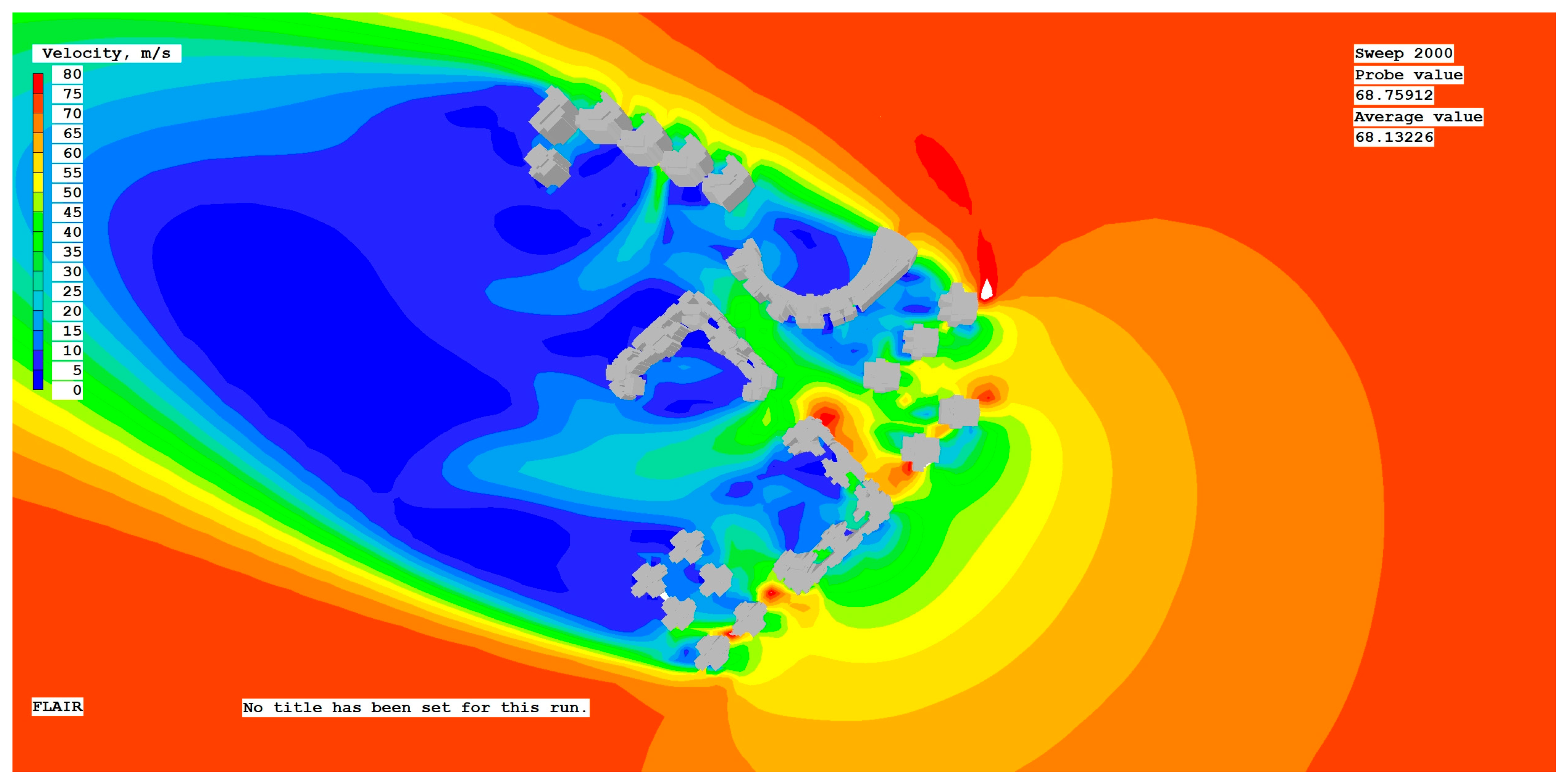

References
- Yu, X.J. Prosperity and challenge: The Macau special administrative region. In Hong Kong, Macau and the Pearl River Delta: A Geographical Survey; Hong Kong Educational Publishing Company Limited: Hong Kong, China, 2009; pp. 236–262. [Google Scholar]
- Chung, T. Valuing heritage in Macau: On contexts and processes of urban conservation. J. Curr. Chin. Aff. 2009, 38, 129–160. [Google Scholar] [CrossRef]
- Hong, B.; Lin, B. Numerical studies of the outdoor wind environment and thermal comfort at pedestrian level in housing blocks with different building layout patterns and trees arrangement. Renew. Energy 2015, 73, 18–27. [Google Scholar] [CrossRef]
- Chen, Q.Y. Using computational tools to factor wind into architectural environment design. Energy Build. 2004, 36, 1197–1209. [Google Scholar] [CrossRef]
- Sanaieian, H.; Tenpierik, M.; Van Den Linden, K.; Seraj, F.M.; Shemrani, S.M.M. Review of the impact of urban block form on thermal performance, solar access and ventilation. Renew. Sustain. Energy Rev. 2014, 38, 551–560. [Google Scholar] [CrossRef]
- Isyumov, N. A Study of the Pedestrian Level Winds for the Canary Wharf Project, London, England; Engineering Science Research Report, BLWT-SS16-1986; Engineering Science Research: London, UK, 1986. [Google Scholar]
- Bottema, M. A method for optimisation of wind discomfort criteria. Build. Environ. 2000, 35, 1–18. [Google Scholar] [CrossRef]
- Zhang, L.; Zhan, Q.; Lan, Y. Effects of the tree distribution and species on outdoor environment conditions in a hot summer and cold winter zone: A case study in Wuhan residential quarters. Build. Environ. 2018, 130, 27–39. [Google Scholar] [CrossRef]
- Hong, B.; Lin, B. Numerical study of the influences of different patterns of the building and green space on micro-scale outdoor thermal comfort and indoor natural ventilation. Build. Simul. 2014, 7, 525–536. [Google Scholar] [CrossRef]
- Ratti, C.; Raydan, D.; Steemers, K. Building form and environmental performance: Archetypes, analysis and an arid climate. Energy Build. 2003, 35, 49–59. [Google Scholar] [CrossRef]
- Hu, Y.; Tan, H.; Deng, F. Analysis of the Impact of Residential Building Layout on Outdoor Wind Environment in Shanghai. Build. Therm. Energy Vent. Air Cond. 2017, 36, 32–37. [Google Scholar]
- Wang, Z.; Gao, Y.; Meng, Q.; Zhao, L.; Jin, L. Research on the Relationship between Building Group Layout and Natural Ventilation. Build. Sci. 2007, 23, 24–27. [Google Scholar]
- Huang, Y. Research on Residential Building Layout Based on Wind Environment Simulation Evaluation. Residence 2022, 111, 126–130. [Google Scholar]
- Hou, Y.; Cheng, R.; Yan, H.; Cai, Y. Wind Environment Simulation and Optimal Design of Existing Buildings in Historic Districts—A Case Study of Xiaoyangzhou Hotel in Qingdao. Urban Archit. 2023, 20, 125–128. [Google Scholar] [CrossRef]
- Zhou, X. Research on Evaluation System of Village and Town Planning and Construction in Xuzhou Area Based on Wind Environment Optimization. Master’s Thesis, China University of Mining and Technology, Xuzhou, China, 2022. [Google Scholar] [CrossRef]
- Liang, X. Study on Optimization of Natural Ventilation System of Tujia Traditional Residential Houses. Master’s Thesis, Guizhou University, Guiyang, China, 2022. [Google Scholar] [CrossRef]
- Luo, M. Research on Green Space Optimization Strategy of High-Rise Residential Areas in Hot Summer and Cold Winter Regions Based on Outdoor Thermal Comfort Evaluation in Summer. Master’s Thesis, Qingdao Technological University, Qingdao, China, 2022. [Google Scholar]
- Xiao, L. Study on the Improvement Strategies of Outdoor Microclimate Adaptability of Coastal Residential Form in Shantou City. Master’s Thesis, Shantou University, Shantou, China, 2022. [Google Scholar] [CrossRef]
- Lv, J. Study on the Relationship between the Spatial Layout of Traditional Villages in Southern Hunan and the Wind-Heat Environment. Master’s Thesis, Nanhua University, Hengyang, China, 2021. [Google Scholar] [CrossRef]
- Yang, L.; Qian, F. Research on the Green Wind Environment Based on Numerical Simulation. Nat. Environ. Pollut. Technol. 2016, 15, 767. [Google Scholar]
- Li, B.; Liu, J.; Luo, F.; Man, X. Evaluation of CFD simulation using various turbulence models for wind pressure on buildings based on wind tunnel experiments. Procedia Eng. 2015, 121, 2209–2216. [Google Scholar] [CrossRef]
- Yang, L.; Qian, F. Wind environment in green building design. Nat. Environ. Pollut. Technol. 2015, 14, 833. [Google Scholar]
- Duan, C. Application of Mathematical Methods Based on Improved Fuzzy Computing in Building and Urban Design in the Environment of Industry 4.0. Comput. Intell. Neurosci. 2022, 2022, 3449431. [Google Scholar] [CrossRef] [PubMed]
- Du, Z.; Guo, W.; Li, W.; Gao, X. A Study on the Optimization of Wind Environment of Existing Villa Buildings in Lingnan Area: A Case Study of Jiangmen’s “Yunshan Poetic” Moon Island Houses. Buildings 2022, 12, 1304. [Google Scholar] [CrossRef]
- Yuan, P.F.; Song, Y.; Lin, Y.; Beh, H.S.; Chao, Y.; Xiao, T.; Huang, S.; Zheng, J.; Wu, Z. An architectural building cluster morphology generation method to perceive, derive, and form based on cyborg-physical wind tunnel (CPWT). Build. Environ. 2021, 203, 108045. [Google Scholar] [CrossRef]
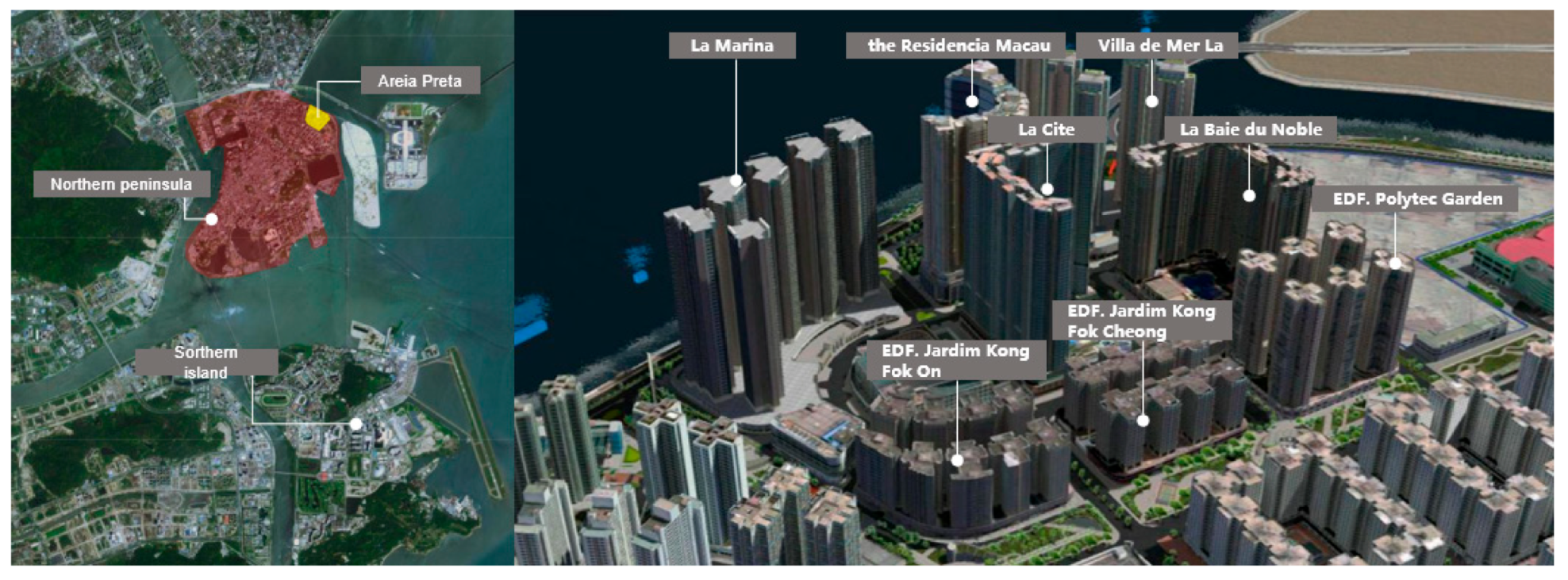

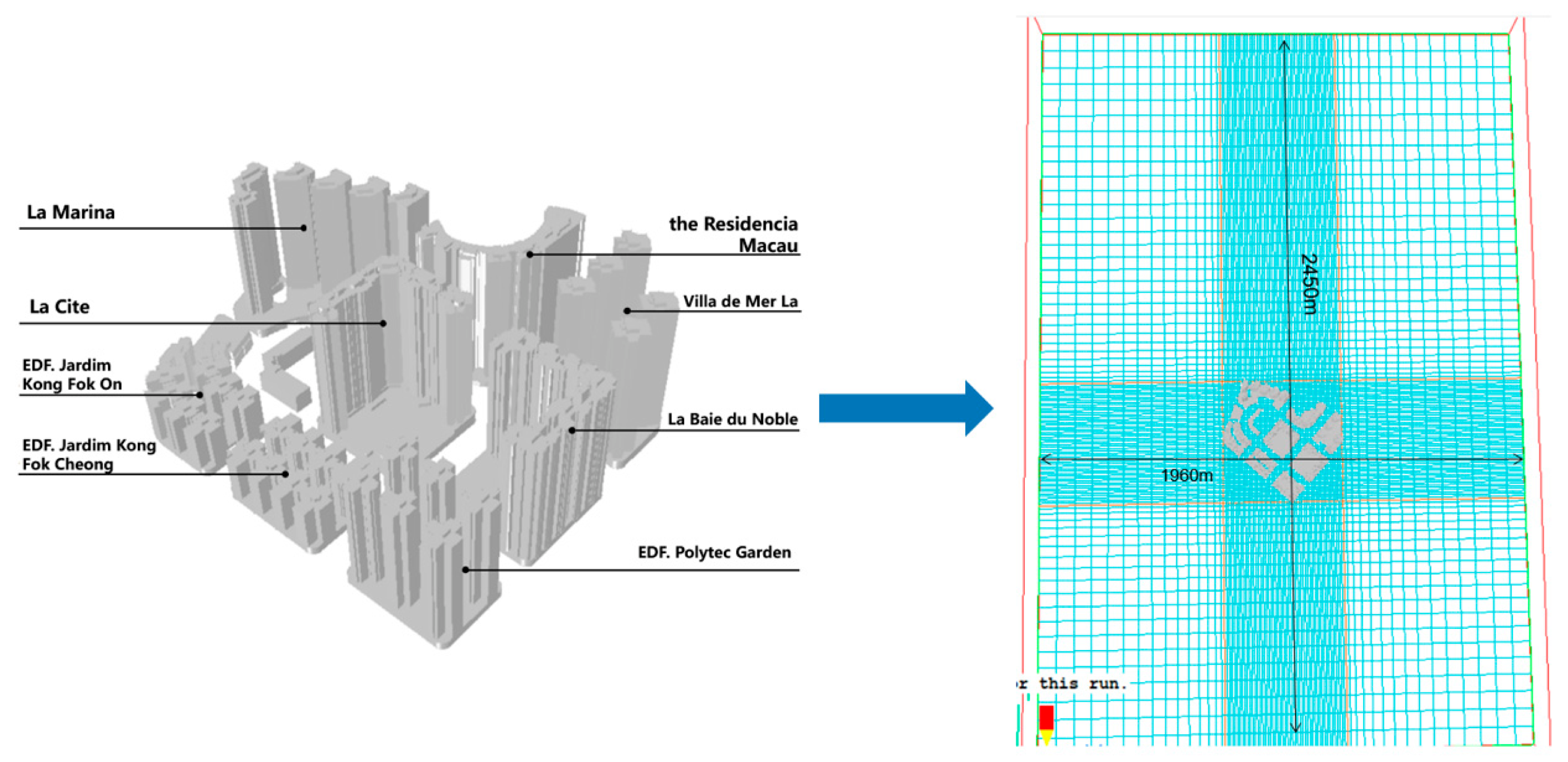
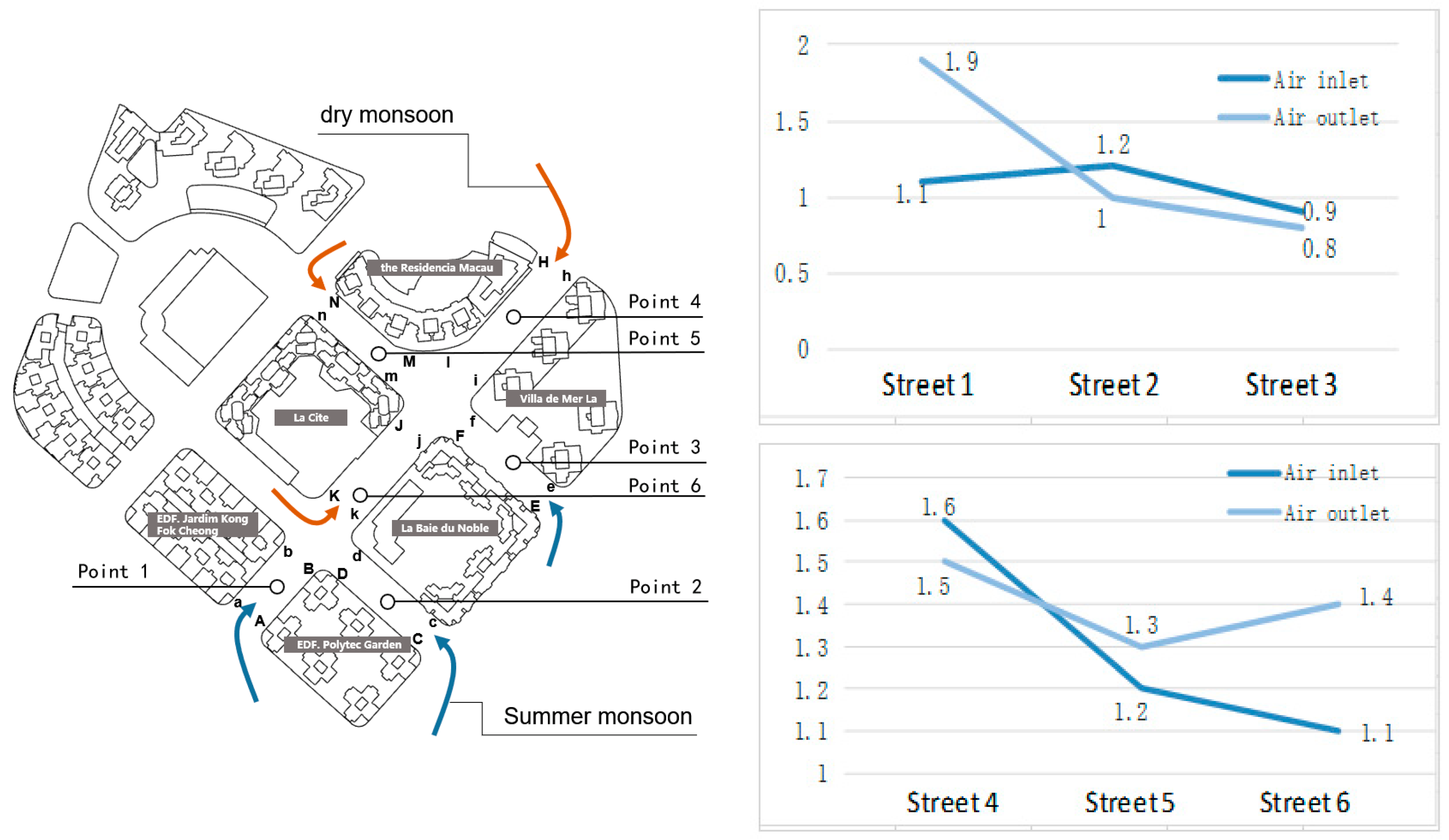
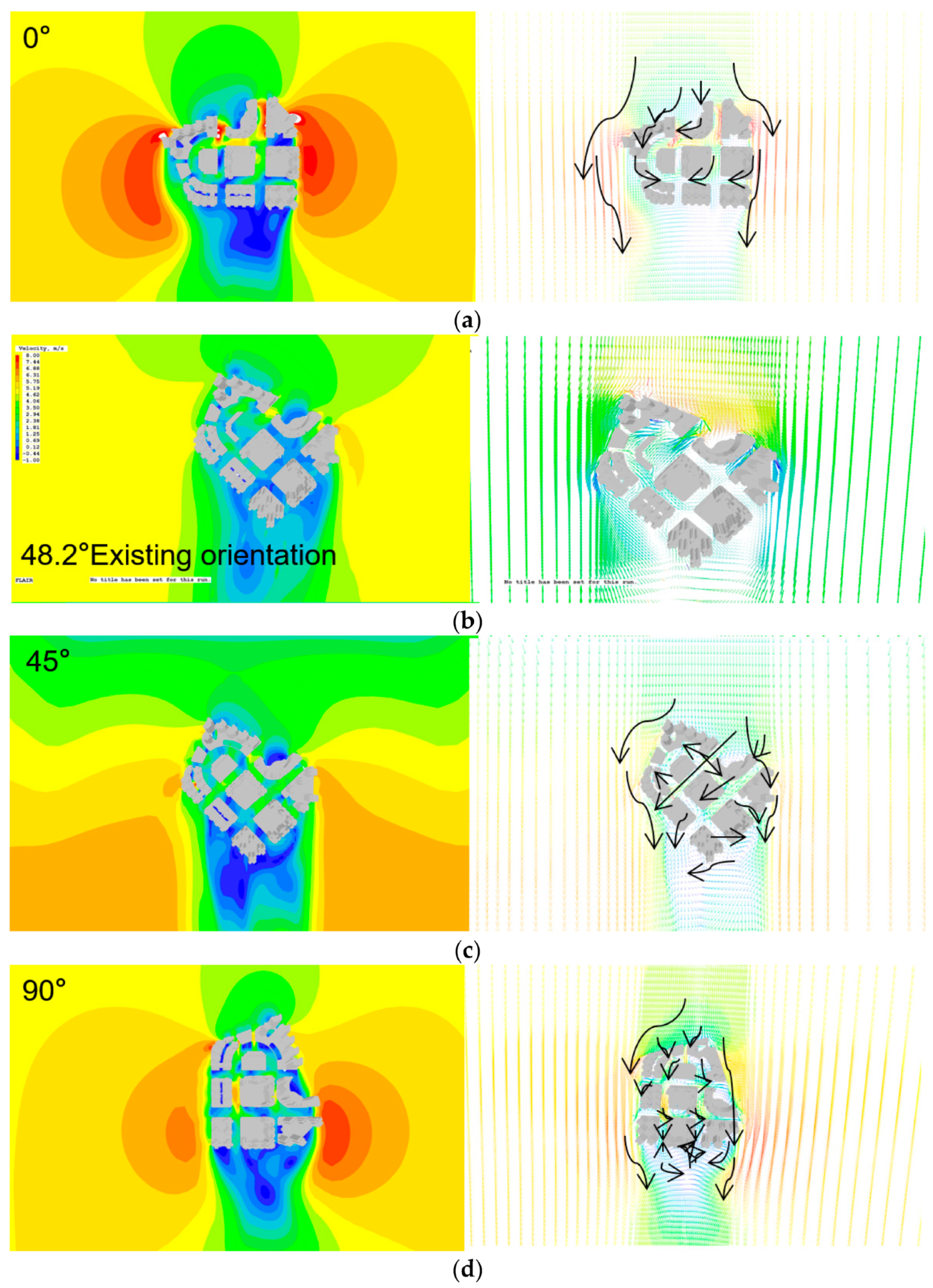

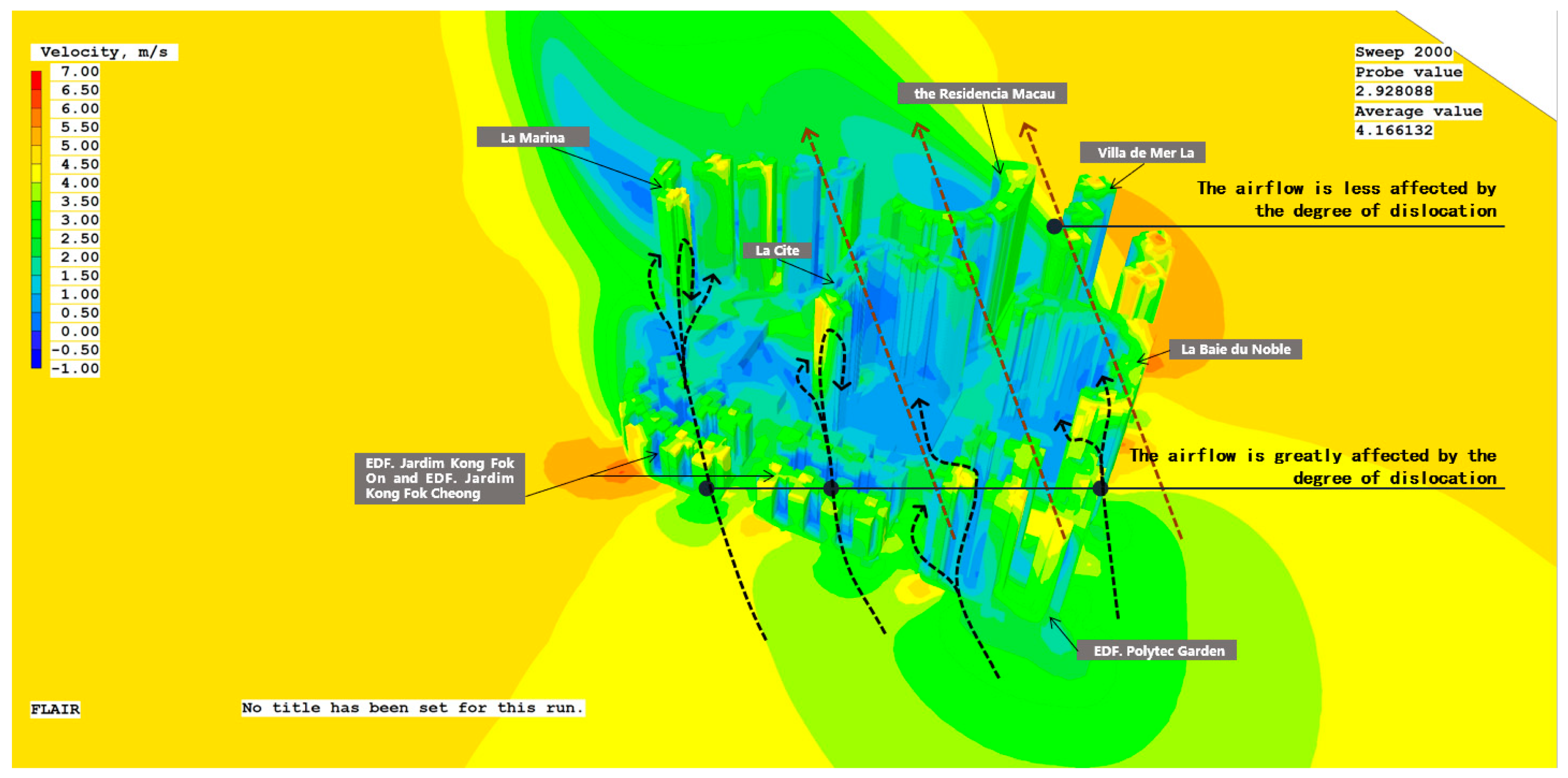
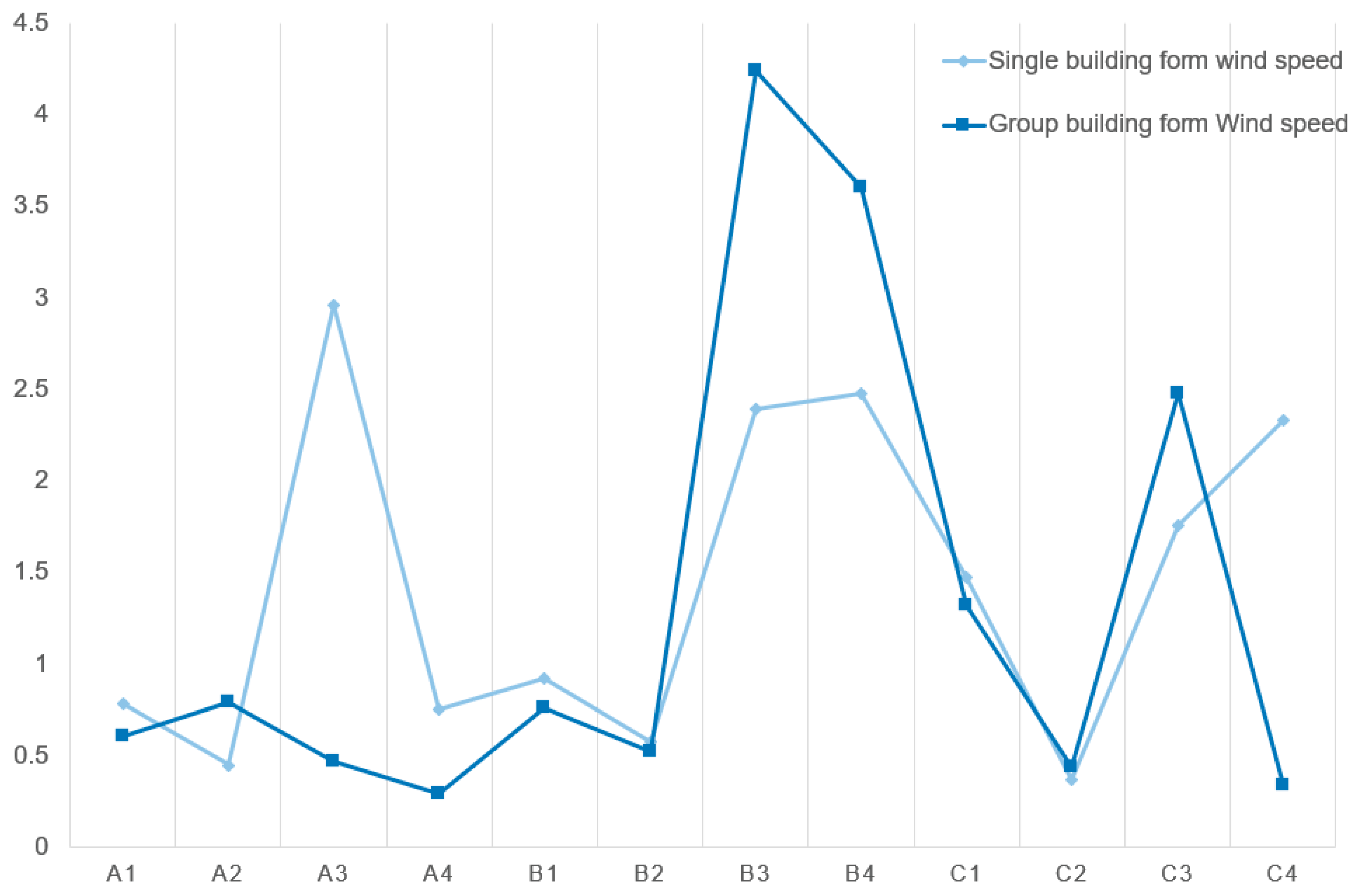
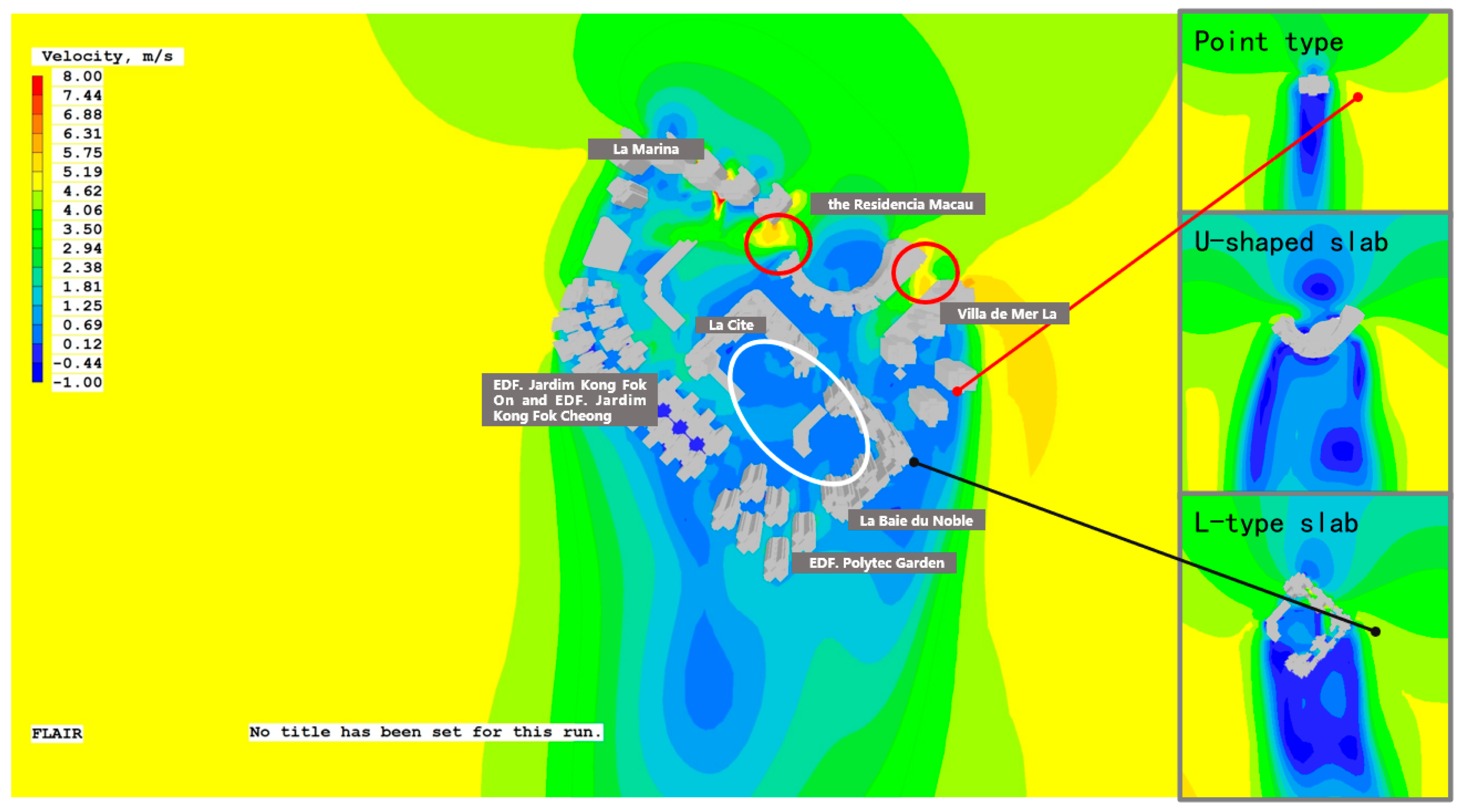
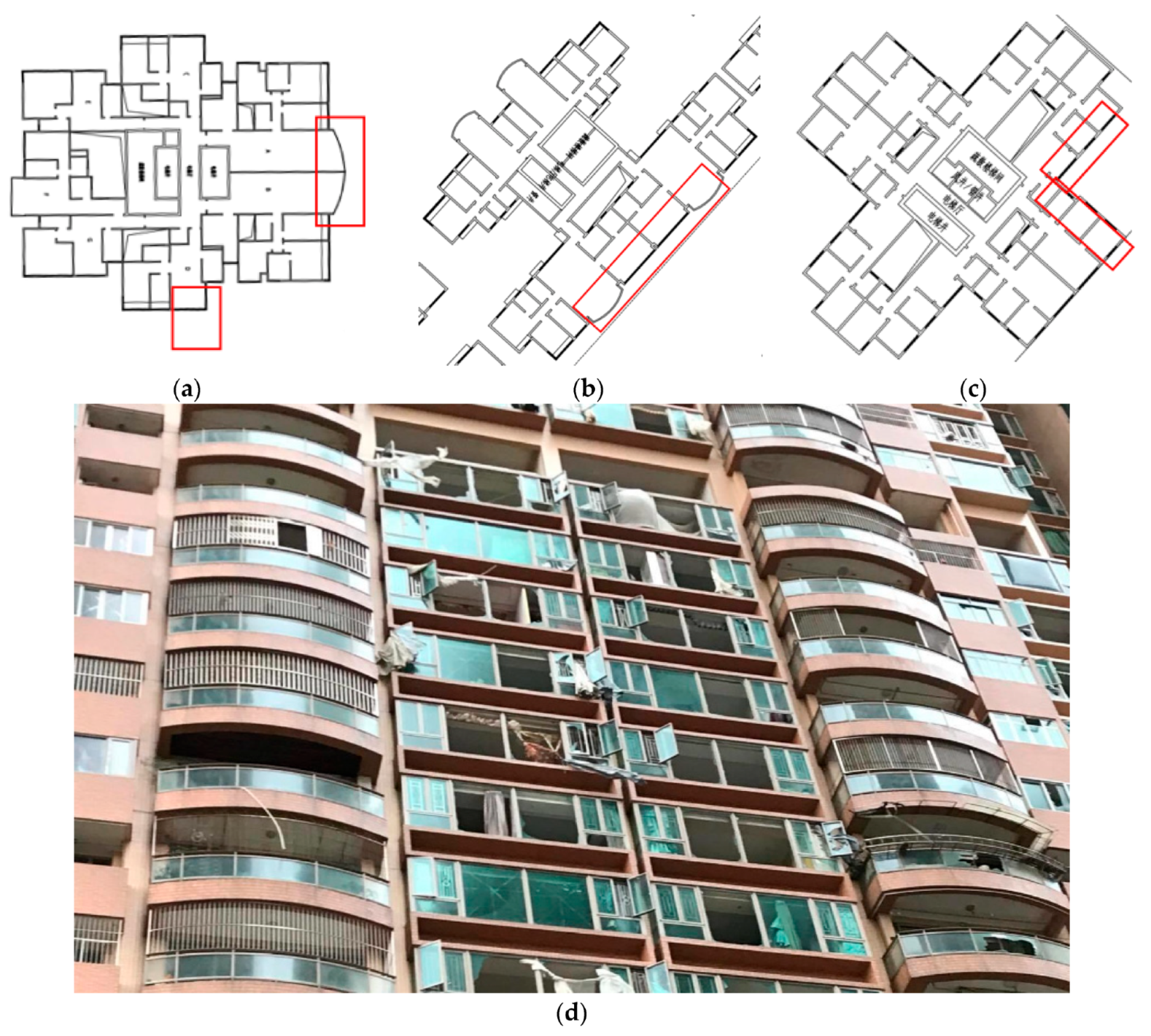

| Effect of the Wind Direction | Set Serial Number | Representative Street Segments | Street Length | Street Aspect Ratios |
|---|---|---|---|---|
| prevailing wind in summer | 1 | EDF. Jardim Kong Fok Cheong—EDF. Polytec Garden Section, Oriental Pearl Street | 78 m | 2.32:1 |
| 2 | EDF. Polytec Garden—La Baie Du Noble Section, Rua Central da Areia Preta | 111 m | 2.50:1 | |
| 3 | Villa de Mer—La Baie Du Noble section, Rua Central da Areia Preta | 111 m | 2.52:1 | |
| prevailing wind in winter | 4 | The Residencia Macau—Villa de Mer section | 138 m | 3.29:1 |
| 5 | The Residencia Macau—La Cite Section, Rua Central da Areia Preta | 111 m | 4.80:1 | |
| 6 | La Cite—La Baie Du Noble Section, Oriental Pearl Street | 114 m | 1.47:1 |
Disclaimer/Publisher’s Note: The statements, opinions and data contained in all publications are solely those of the individual author(s) and contributor(s) and not of MDPI and/or the editor(s). MDPI and/or the editor(s) disclaim responsibility for any injury to people or property resulting from any ideas, methods, instructions or products referred to in the content. |
© 2023 by the authors. Licensee MDPI, Basel, Switzerland. This article is an open access article distributed under the terms and conditions of the Creative Commons Attribution (CC BY) license (https://creativecommons.org/licenses/by/4.0/).
Share and Cite
He, J.; Chen, Y.; Zheng, L.; Zheng, J. Research on Wind Environment and Morphological Effects of High-Rise Buildings in Macau: An Example from the New Reclamation Area around Areia Preta. Int. J. Environ. Res. Public Health 2023, 20, 4143. https://doi.org/10.3390/ijerph20054143
He J, Chen Y, Zheng L, Zheng J. Research on Wind Environment and Morphological Effects of High-Rise Buildings in Macau: An Example from the New Reclamation Area around Areia Preta. International Journal of Environmental Research and Public Health. 2023; 20(5):4143. https://doi.org/10.3390/ijerph20054143
Chicago/Turabian StyleHe, Jialun, Yile Chen, Liang Zheng, and Jianyi Zheng. 2023. "Research on Wind Environment and Morphological Effects of High-Rise Buildings in Macau: An Example from the New Reclamation Area around Areia Preta" International Journal of Environmental Research and Public Health 20, no. 5: 4143. https://doi.org/10.3390/ijerph20054143
APA StyleHe, J., Chen, Y., Zheng, L., & Zheng, J. (2023). Research on Wind Environment and Morphological Effects of High-Rise Buildings in Macau: An Example from the New Reclamation Area around Areia Preta. International Journal of Environmental Research and Public Health, 20(5), 4143. https://doi.org/10.3390/ijerph20054143










